₹365.00
Share with your Friends
IGNOU MMTE-001 Assignment Question Paper 2023
ii) Every 2-connected bipartite graph is Hamiltonian.
iii) For some nonnegative integers
iv) Grötzsch graph is Eulerian.
v)
vi) The vertex-covering number of an odd cycle is 1 more than its independence number.
vii) The complement of a disconnected graph is connected.
viii) If
ix) The line graph of the Petersen graph has 30 edges.
x) There exists a complete binary tree on 15 vertices.






- (a) Let
G G H H L(G)~=L(H) L(G) \cong L(H) G~=H G \cong H
MMTE-001 Sample Solution 2023
Question:-01
Frequently Asked Questions (FAQs)
You can access the Complete Solution through our app, which can be downloaded using this link:
Simply click “Install” to download and install the app, and then follow the instructions to purchase the required assignment solution. Currently, the app is only available for Android devices. We are working on making the app available for iOS in the future, but it is not currently available for iOS devices.
Yes, It is Complete Solution, a comprehensive solution to the assignments for IGNOU.
Yes, the Complete Solution is aligned with the requirements and has been solved accordingly.
Yes, the Complete Solution is guaranteed to be error-free.The solutions are thoroughly researched and verified by subject matter experts to ensure their accuracy.
As of now, you have access to the Complete Solution for a period of 1 Year after the date of purchase, which is sufficient to complete the assignment. However, we can extend the access period upon request. You can access the solution anytime through our app.
The app provides complete solutions for all assignment questions. If you still need help, you can contact the support team for assistance at Whatsapp +91-9958288900
No, access to the educational materials is limited to one device only, where you have first logged in. Logging in on multiple devices is not allowed and may result in the revocation of access to the educational materials.
Payments can be made through various secure online payment methods available in the app.Your payment information is protected with industry-standard security measures to ensure its confidentiality and safety. You will receive a receipt for your payment through email or within the app, depending on your preference.
The instructions for formatting your assignments are detailed in the Assignment Booklet, which includes details on paper size, margins, precision, and submission requirements. It is important to strictly follow these instructions to facilitate evaluation and avoid delays.
Terms and Conditions
- The educational materials provided in the app are the sole property of the app owner and are protected by copyright laws.
- Reproduction, distribution, or sale of the educational materials without prior written consent from the app owner is strictly prohibited and may result in legal consequences.
- Any attempt to modify, alter, or use the educational materials for commercial purposes is strictly prohibited.
- The app owner reserves the right to revoke access to the educational materials at any time without notice for any violation of these terms and conditions.
- The app owner is not responsible for any damages or losses resulting from the use of the educational materials.
- The app owner reserves the right to modify these terms and conditions at any time without notice.
- By accessing and using the app, you agree to abide by these terms and conditions.
- Access to the educational materials is limited to one device only. Logging in to the app on multiple devices is not allowed and may result in the revocation of access to the educational materials.
Our educational materials are solely available on our website and application only. Users and students can report the dealing or selling of the copied version of our educational materials by any third party at our email address (abstract4math@gmail.com) or mobile no. (+91-9958288900).
In return, such users/students can expect free our educational materials/assignments and other benefits as a bonafide gesture which will be completely dependent upon our discretion.
Related products

IGNOU MPC-001 Solved Assignment 2022-2023 | MAPC | Cognitive Psychology, Learning and Memory
₹101.00Please read the following points before ordering this IGNOU Assignment Solution.
Categories: IGNOU Assignment Solution, M.A. Psychology, MAPC 2022-2023 Tags: "IGNOU, 2022-2023, Buy IGNOU MPC-001 Assignment, Cognitive Psychology, Cognitive Psychology Assignment, IGNOU Assignment Solutions, IGNOU MAPC Assignment, IGNOU MPC-001, Learning, Learning and Memory Assignment, MAPC, Memory, MPC-001, Solved Assignment, Solved Assignment 2022-2023
IGNOU MEG-14 Solved Assignment 2022-2023 | MEG | Contemporary Indian Literature in English Translation
₹101.00Please read the following points before ordering this IGNOU Assignment Solution.
Categories: IGNOU Assignment Solution, MA MEG, MA MEG 2022-2023 Tags: "IGNOU, 2022-2023, Contemporary Indian Literature, Contemporary Indian Literature in English Translation, English Translation, expert-written assignments, IGNOU MEG-14 Solved Assignment, MEG, MEG-14, Solved Assignment, study materials
IGNOU MEG-12 Solved Assignment 2022-2023 | MEG | A Survey Course in 20th Century Canadian Literature
₹101.00Please read the following points before ordering this IGNOU Assignment Solution.
Categories: IGNOU Assignment Solution, MA MEG, MA MEG 2022-2023 Tags: 2022-2023 MEG, 20th Century Canadian Literature, IGNOU MEG-12 Assignment, IGNOU Solved Assignment, MEG-12 Assignment Solution, MEG-12 IGNOU Assignment Solution., Survey Course in 20th Century Canadian Literature, Survey Course in Canadian Literature.
IGNOU MEG-03 Solved Assignment 2022-2023 | MEG | British Novel
₹101.00Please read the following points before ordering this IGNOU Assignment Solution.
Categories: IGNOU Assignment Solution, MA MEG, MA MEG 2022-2023 Tags: Accurate solutions, British literature, British Novel, expert-written assignments, High-quality assignments, IGNOU assignments, IGNOU assignments solutions, IGNOU courses, IGNOU education, IGNOU MEG, IGNOU MEG-03, IGNOU MEG-03 Solved Assignment 2022-2023, IGNOU Study Material, MEG

IGNOU MSTE-004 Previous Year Paper Solution | PGDAST
₹365.00Solved Papers – Dec 2022 to Dec 2023 (Total 3 Papers)
Access via our Android App or any Web browser.
Please read the following points before ordering :

IGNOU MSTE-003 Previous Year Paper Solution | PGDAST
₹365.00Solved Papers – Dec 2022 to Dec 2023 (Total 3 Papers)
Access via our Android App or any Web browser.
Please read the following points before ordering :

IGNOU MSTE-002 Previous Year Paper Solution | PGDAST
₹365.00Solved Papers – June 2015 to Dec 2023 (Total 18 Papers)
Access via our Android App or any Web browser.
Please read the following points before ordering :

IGNOU MSTE-001 Previous Year Paper Solution | PGDAST
₹365.00Solved Papers – Dec 2015 to Dec 2023 (Total 17 Papers)
Access via our Android App or any Web browser.
Please read the following points before ordering :

IGNOU MST-004 Previous Year Paper Solution | PGDAST
₹365.00Solved Papers – June 2015 to Dec 2023 (Total 18 Papers)
Access via our Android App or any Web browser.
Please read the following points before ordering :

IGNOU MST-019 Solved Assignment 2024 | MSCAST | IGNOU
₹365.00Access via our Android App Only
Please read the following points before ordering :

IGNOU MST-018 Solved Assignment 2024 | MSCAST | IGNOU
₹365.00Access via our Android App Only
Please read the following points before ordering :

IGNOU MST-017 Solved Assignment 2024 | MSCAST | IGNOU
₹365.00Access via our Android App Only
Please read the following points before ordering :

IGNOU MST-016 Solved Assignment 2024 | MSCAST | IGNOU
₹365.00Access via our Android App Only
Please read the following points before ordering :

IGNOU MPH-005 Solved Assignment 2024 | MSCPH | IGNOU
₹365.00Access via our Android App Only
Please read the following points before ordering :

IGNOU MPH-004 Solved Assignment 2024 | MSCPH | IGNOU
₹365.00Access via our Android App Only
Please read the following points before ordering :

IGNOU MPH-003 Solved Assignment 2024 | MSCPH | IGNOU
₹365.00Access via our Android App Only
Please read the following points before ordering :

IGNOU MPH-002 Solved Assignment 2024 | MSCPH | IGNOU
₹365.00Access via our Android App Only
Please read the following points before ordering :

IGNOU MPH-001 Solved Assignment 2024 | MSCPH | IGNOU
₹365.00Access via our Android App Only
Please read the following points before ordering :

IGNOU BZYET-143 Solved Assignment 2024 | B.Sc. CBCS Zoology
₹49.00Please read the following points before ordering this IGNOU Assignment Solution.

IGNOU BZYET-141 Solved Assignment 2024 | B.Sc. CBCS Zoology
₹49.00Please read the following points before ordering this IGNOU Assignment Solution.

IGNOU BZYCT-137 Solved Assignment 2024 | B.Sc. CBCS Zoology
₹49.00Please read the following points before ordering this IGNOU Assignment Solution.

IGNOU BZYCT-135 Solved Assignment 2024 | B.Sc. CBCS Zoology
₹49.00Please read the following points before ordering this IGNOU Assignment Solution.

IGNOU MMT-007 Solved Assignment 2024 | M.Sc. MACS
₹365.00Access via our Android App Only
Please read the following points before ordering :

IGNOU MMT-005 Solved Assignment 2024 | M.Sc. MACS
₹365.00Access via our Android App Only
Please read the following points before ordering :

IGNOU MMT-004 Solved Assignment 2024 | M.Sc. MACS
₹365.00Access via our Android App Only
Please read the following points before ordering :

IGNOU MMT-002 Solved Assignment 2024 | M.Sc. MACS
₹365.00Access via our Android App Only
Please read the following points before ordering :

IGNOU MMT-001 Solved Assignment 2024 | M.Sc. MACS
₹365.00Access via our Android App Only
Please read the following points before ordering :

IGNOU MMT-008 Solved Assignment 2024 | M.Sc. MACS
₹365.00Access via our Android App Only
Please read the following points before ordering :

IGNOU MMTE-001 Solved Assignment 2024 | M.Sc. MACS
₹365.00Access via our Android App Only
Please read the following points before ordering :

IGNOU MMTE-002 Solved Assignment 2024 | M.Sc. MACS
₹365.00Access via our Android App Only
Please read the following points before ordering :

IGNOU MMT-009 Solved Assignment 2024 | M.Sc. MACS
₹365.00Access via our Android App Only
Please read the following points before ordering :

IGNOU MMTE-004 Solved Assignment 2024 | M.Sc. MACS
₹365.00Access via our Android App Only
Please read the following points before ordering :

IGNOU MMTE-003 Solved Assignment 2024 | M.Sc. MACS
₹365.00Access via our Android App Only
Please read the following points before ordering :

IGNOU MMT-006 Solved Assignment 2024 | M.Sc. MACS
₹365.00Access via our Android App Only
Please read the following points before ordering :

IGNOU MMT-003 Solved Assignment 2024 | M.Sc. MACS
₹365.00Access via our Android App Only
Please read the following points before ordering :

IGNOU BCHET-147 Solved Assignment 2024 | B.Sc. CBCS Chemistry
₹49.00Please read the following points before ordering this IGNOU Assignment Solution.

IGNOU BCHET-141 Solved Assignment 2024 | B.Sc. CBCS Chemistry
₹49.00Please read the following points before ordering this IGNOU Assignment Solution.

IGNOU BCHCT-137 Solved Assignment 2024 | B.Sc. CBCS Chemistry
₹49.00Please read the following points before ordering this IGNOU Assignment Solution.

IGNOU BCHCT-135 Solved Assignment 2024 | B.Sc. CBCS Chemistry
₹49.00Please read the following points before ordering this IGNOU Assignment Solution.

IGNOU BPHET-143 Solved Assignment 2024 | B.Sc (G) CBCS
₹101.00Please read the following points before ordering this IGNOU Assignment Solution.

IGNOU BPHET-141 Solved Assignment 2024 | B.Sc (G) CBCS
₹101.00Please read the following points before ordering this IGNOU Assignment Solution.

IGNOU BPHCT-137 Solved Assignment 2024 | B.Sc (G) CBCS
₹101.00Please read the following points before ordering this IGNOU Assignment Solution.

IGNOU BPHCT-135 Solved Assignment 2024 | B.Sc (G) CBCS
₹101.00Please read the following points before ordering this IGNOU Assignment Solution.

IGNOU BPHCT-133 Solved Assignment 2024 | B.Sc (G) CBCS
₹101.00Please read the following points before ordering this IGNOU Assignment Solution.

IGNOU BPHCT-131 Solved Assignment 2024 | B.Sc (G) CBCS
₹101.00Please read the following points before ordering this IGNOU Assignment Solution.

IGNOU BBYET-143 Solved Assignment 2024 | B.Sc. CBCS Botany
₹49.00Please read the following points before ordering this IGNOU Assignment Solution.

IGNOU BBYET-141 Solved Assignment 2024 | B.Sc. CBCS Botany
₹49.00Please read the following points before ordering this IGNOU Assignment Solution.

IGNOU BBYCT-137 Solved Assignment 2024 | B.Sc. CBCS Botany
₹49.00Please read the following points before ordering this IGNOU Assignment Solution.

IGNOU BBYCT-135 Solved Assignment 2024 | B.Sc. CBCS Botany
₹49.00Please read the following points before ordering this IGNOU Assignment Solution.

IGNOU BBYCT-133 Solved Assignment 2024 | B.Sc. CBCS Botany
₹49.00Please read the following points before ordering this IGNOU Assignment Solution.

IGNOU BBYCT-131 Solved Assignment 2024 | B.Sc. CBCS Botany
₹49.00Please read the following points before ordering this IGNOU Assignment Solution.

IGNOU BZYCT-133 Solved Assignment 2024 | B.Sc. CBCS Zoology
₹49.00Please read the following points before ordering this IGNOU Assignment Solution.

IGNOU BZYCT-131 Solved Assignment 2024 | B.Sc. CBCS Zoology
₹49.00Please read the following points before ordering this IGNOU Assignment Solution.

IGNOU BCHCT-133 Solved Assignment 2024 | B.Sc. CBCS Chemistry
₹49.00Please read the following points before ordering this IGNOU Assignment Solution.

IGNOU BCHCT-131 Solved Assignment 2024 | B.Sc. CBCS Chemistry
₹49.00Please read the following points before ordering this IGNOU Assignment Solution.

IGNOU BEGAE-182 Solved Assignment 2024 | CBCS
₹49.00Please read the following points before ordering this IGNOU Assignment Solution.

IGNOU BEVAE-181 Solved Assignment 2024 | B.Sc (G) CBCS AECC
₹49.00Please read the following points before ordering this IGNOU Assignment Solution.

IGNOU BMTC-132 Solved Assignment 2024 | B.Sc (G) CBCS
₹101.00Please read the following points before ordering this IGNOU Assignment Solution.

IGNOU BMTC-131 Solved Assignment 2024 | B.Sc (G) CBCS
₹101.00Please read the following points before ordering this IGNOU Assignment Solution.

IGNOU BMTC-133 Solved Assignment 2024 | B.Sc (G) CBCS
₹101.00Please read the following points before ordering this IGNOU Assignment Solution.

IGNOU BMTC-134 Solved Assignment 2024 | B.Sc (G) CBCS
₹101.00Please read the following points before ordering this IGNOU Assignment Solution.

IGNOU BMTE-144 Solved Assignment 2024 | B.Sc (G) CBCS
₹101.00Please read the following points before ordering this IGNOU Assignment Solution.

IGNOU BMTE-141 Solved Assignment 2024 | B.Sc (G) CBCS
₹101.00Please read the following points before ordering this IGNOU Assignment Solution.

IGNOU MSTE-004 Solved Assignment 2024 | PGDAST
₹351.00Access via our Android App Only
Please read the following points before ordering :

IGNOU MSTE-003 Solved Assignment 2024 | PGDAST
₹351.00Access via our Android App Only
Please read the following points before ordering :

IGNOU MSTE-002 Solved Assignment 2024 | PGDAST
₹351.00Access via our Android App Only
Please read the following points before ordering :

IGNOU MSTE-001 Solved Assignment 2024 | PGDAST
₹351.00Access via our Android App Only
Please read the following points before ordering :

IGNOU MST-005 Solved Assignment 2024 | PGDAST
₹351.00Access via our Android App Only
Please read the following points before ordering :

IGNOU MST-004 Solved Assignment 2024 | PGDAST
₹351.00Access via our Android App Only
Please read the following points before ordering :

IGNOU MST-003 Solved Assignment 2024 | PGDAST
₹351.00Access via our Android App Only
Please read the following points before ordering :

IGNOU MST-002 Solved Assignment 2024 | PGDAST
₹351.00Access via our Android App Only
Please read the following points before ordering :

IGNOU MST-001 Solved Assignment 2024 | PGDAST
₹351.00Access via our Android App Only
Please read the following points before ordering :

IGNOU MST-003 Previous Year Paper Solution | PGDAST
₹365.00Solved Papers – June 2015 to Dec 2023 (Total 18 Papers)
Access via our Android App or any Web browser.
Please read the following points before ordering :

IGNOU MST-005 Previous Year Paper Solution | PGDAST
₹365.00Solved Papers – Dec 2015 to Dec 2023 (Total 17 Papers)
Access via our Android App or any Web browser.
Please read the following points before ordering :

IGNOU MST-002 Previous Year Paper Solution | PGDAST
₹365.00Solved Papers – June 2015 to Dec 2023 (Total 18 Papers)
Access via our Android App or any Web browser.
Please read the following points before ordering :

IGNOU MMTE-001 Solved Assignment 2023 | M.Sc. MACS
₹365.00Access via our Android App Only
Please read the following points before ordering :

UPSC Previous Years Maths Optional Papers with Solution | Paper-02
₹1,095.00Available on our Android App as well.
Please read the following points before ordering :

UPSC Previous Years Maths Optional Papers with Solution | Paper-01
₹1,095.00Available on our Android App as well.
Please read the following points before ordering :

IGNOU MST-015 Solved Assignment 2023 | MSCAST
₹365.00Access via our Android App Only
Please read the following points before ordering :

IGNOU MST-014 Solved Assignment 2023 | MSCAST
₹365.00Access via our Android App Only
Please read the following points before ordering :

IGNOU MST-013 Solved Assignment 2023 | MSCAST
₹365.00Access via our Android App Only
Please read the following points before ordering :

IGNOU MST-012 Solved Assignment 2023 | MSCAST
₹365.00Access via our Android App Only
Please read the following points before ordering :

IGNOU MST-011 Solved Assignment 2023 | MSCAST
₹365.00Access via our Android App Only
Please read the following points before ordering :

IGNOU MMT-008 Solved Assignment 2023 | M.Sc. MACS
₹365.00Access via our Android App Only
Please read the following points before ordering :

IGNOU MMT-006 Solved Assignment 2023 | M.Sc. MACS
₹365.00Access via our Android App Only
Please read the following points before ordering :

IGNOU MMT-003 Solved Assignment 2023 | M.Sc. MACS
₹365.00Access via our Android App Only
Please read the following points before ordering :

IGNOU MST-001 Previous Year Paper Solution | PGDAST
₹365.00Solved Papers – June 2015 to Dec 2023 (Total 18 Papers)
Access via our Android App or any Web browser.
Please read the following points before ordering :

IGNOU MEV-019 Solved Assignment 2023-2024 | MSCENV
₹101.00Access via our Android App Only
Please read the following points before ordering :

IGNOU MEV-018 Solved Assignment 2023-2024 | MSCENV
₹101.00Access via our Android App Only
Please read the following points before ordering :
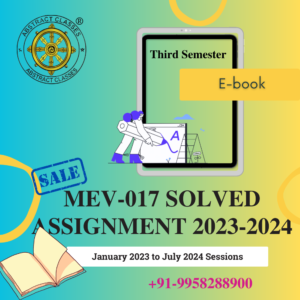
IGNOU MEV-017 Solved Assignment 2023-2024 | MSCENV
₹101.00Access via our Android App Only
Please read the following points before ordering :

IGNOU MEV-016 Solved Assignment 2023-2024 | MSCENV
₹101.00Access via our Android App Only
Please read the following points before ordering :

IGNOU MEV-015 Solved Assignment 2023-2024 | MSCENV
₹101.00Access via our Android App Only
Please read the following points before ordering :

IGNOU MEV-014 Solved Assignment 2023-2024 | MSCENV
₹101.00Access via our Android App Only
Please read the following points before ordering :

IGNOU MEV-013 Solved Assignment 2023-2024 | MSCENV
₹101.00Access via our Android App Only
Please read the following points before ordering :

IGNOU MEV-012 Solved Assignment 2023-2024 | MSCENV
₹101.00Access via our Android App Only
Please read the following points before ordering :

IGNOU MEV-011 Solved Assignment 2023-2024 | MSCENV
₹101.00Access via our Android App Only
Please read the following points before ordering :

IGNOU BCHET-149 Solved Assignment 2023 | B.Sc (G) CBCS
₹101.00Please read the following points before ordering this IGNOU Assignment Solution.

IGNOU BCHET-147 Solved Assignment 2023 | B.Sc (G) CBCS
₹101.00Please read the following points before ordering this IGNOU Assignment Solution.

IGNOU BCHET-141 Solved Assignment 2023 | B.Sc (G) CBCS
₹101.00Please read the following points before ordering this IGNOU Assignment Solution.

IGNOU BCHCT-137 Solved Assignment 2023 | B.Sc (G) CBCS
₹101.00Please read the following points before ordering this IGNOU Assignment Solution.

IGNOU BCHCT-135 Solved Assignment 2023 | B.Sc (G) CBCS
₹101.00Please read the following points before ordering this IGNOU Assignment Solution.

IGNOU BPHET-143 Solved Assignment 2023 | B.Sc. CBCS
₹101.00Access via our Android App Only
Please read the following points before ordering :

IGNOU BPHET-141 Solved Assignment 2023 | B.Sc. CBCS
₹101.00Access via our Android App Only
Please read the following points before ordering :

IGNOU BPHCT-137 Solved Assignment 2023 | B.Sc. CBCS
₹101.00Access via our Android App Only
Please read the following points before ordering :

IGNOU BPHCT-135 Solved Assignment 2023 | B.Sc. CBCS
₹101.00Access via our Android App Only
Please read the following points before ordering :

IGNOU BMTE-144 Solved Assignment 2023 | B.Sc (G) CBCS
₹101.00Please read the following points before ordering this IGNOU Assignment Solution.

IGNOU MEG-19 Solved Assignment 2023-2024 | MA MEG
₹101.00Access via our Android App Only
Please read the following points before ordering :

IGNOU MEG-18 Solved Assignment 2023-2024 | MA MEG
₹101.00Access via our Android App Only
Please read the following points before ordering :

IGNOU MEG-17 Solved Assignment 2023-2024 | MA MEG
₹101.00Access via our Android App Only
Please read the following points before ordering :

IGNOU MEG-16 Solved Assignment 2023-2024 | MA MEG
₹101.00Access via our Android App Only
Please read the following points before ordering :

IGNOU MEG-15 Solved Assignment 2023-2024 | MA MEG
₹101.00Access via our Android App Only
Please read the following points before ordering :

IGNOU MEG-14 Solved Assignment 2023-2024 | MA MEG
₹101.00Access via our Android App Only
Please read the following points before ordering :

IGNOU MEG-13 Solved Assignment 2023-2024 | MA MEG
₹101.00Access via our Android App Only
Please read the following points before ordering :

IGNOU MEG-12 Solved Assignment 2023-2024 | MA MEG
₹101.00Access via our Android App Only
Please read the following points before ordering :

IGNOU MEG-11 Solved Assignment 2023-2024 | MA MEG
₹101.00Access via our Android App Only
Please read the following points before ordering :

IGNOU MEG-10 Solved Assignment 2023-2024 | MA MEG
₹101.00Access via our Android App Only
Please read the following points before ordering :

IGNOU MEG-09 Solved Assignment 2023-2024 | MA MEG
₹101.00Access via our Android App Only
Please read the following points before ordering :

IGNOU MEG-08 Solved Assignment 2023-2024 | MA MEG
₹101.00Access via our Android App Only
Please read the following points before ordering :

IGNOU MEG-07 Solved Assignment 2023-2024 | MA MEG
₹101.00Access via our Android App Only
Please read the following points before ordering :

IGNOU MEG-06 Solved Assignment 2023-2024 | MA MEG
₹101.00Access via our Android App Only
Please read the following points before ordering :

IGNOU MEG-05 Solved Assignment 2023-2024 | MA MEG
₹101.00Access via our Android App Only
Please read the following points before ordering :

IGNOU MEG-04 Solved Assignment 2023-2024 | MA MEG
₹101.00Access via our Android App Only
Please read the following points before ordering :

IGNOU MEG-03 Solved Assignment 2023-2024 | MA MEG
₹101.00Access via our Android App Only
Please read the following points before ordering :

IGNOU MEG-02 Solved Assignment 2023-2024 | MA MEG
₹101.00Access via our Android App Only
Please read the following points before ordering :

IGNOU MEG-01 Solved Assignment 2023-2024 | MA MEG
₹101.00Access via our Android App Only
Please read the following points before ordering :

IGNOU MMT-007 Solved Assignment 2023 | M.Sc. MACS
₹351.00Access via our Android App Only
Please read the following points before ordering :

IGNOU MMT-005 Solved Assignment 2023 | M.Sc. MACS
₹351.00Access via our Android App Only
Please read the following points before ordering :

IGNOU MMT-004 Solved Assignment 2023 | M.Sc. MACS
₹351.00Access via our Android App Only
Please read the following points before ordering :

IGNOU MMT-002 Solved Assignment 2023 | M.Sc. MACS
₹351.00Access via our Android App Only
Please read the following points before ordering :

IGNOU MSTL-002 Solved Assignment 2023 | PGDAST
₹401.00Access via our Android App Only
Please read the following points before ordering :

IGNOU MSTL-001 Solved Assignment 2023 | PGDAST
₹401.00Access via our Android App Only
Please read the following points before ordering :

IGNOU PHE-06 Solved Assignment 2023
₹201.00Please read the following points before ordering this IGNOU Assignment Solution.

IGNOU BCHCT-133 Solved Assignment 2023 | B.Sc (G) CBCS
₹101.00Please read the following points before ordering this IGNOU Assignment Solution.

IGNOU BCHCT-131 Solved Assignment 2023 | B.Sc (G) CBCS
₹101.00Please read the following points before ordering this IGNOU Assignment Solution.
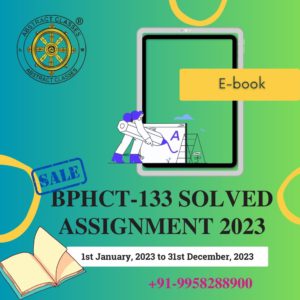
IGNOU BPHCT-133 Solved Assignment 2023 | B.Sc (G) CBCS
₹101.00Please read the following points before ordering this IGNOU Assignment Solution.
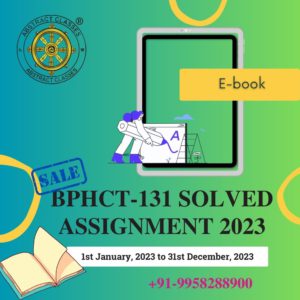
IGNOU BPHCT-131 Solved Assignment 2023 | B.Sc (G) CBCS
₹101.00Please read the following points before ordering this IGNOU Assignment Solution.
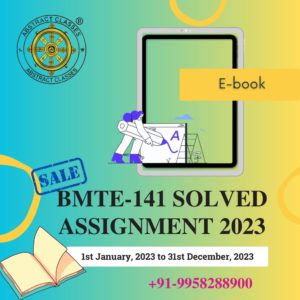
IGNOU BMTE-141 Solved Assignment 2023 | B.Sc (G) CBCS
₹101.00Please read the following points before ordering this IGNOU Assignment Solution.
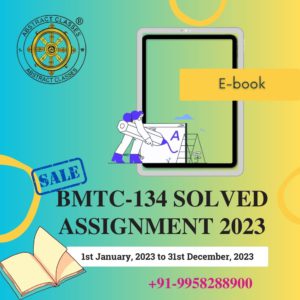
IGNOU BMTC-134 Solved Assignment 2023 | B.Sc (G) CBCS
₹101.00Please read the following points before ordering this IGNOU Assignment Solution.
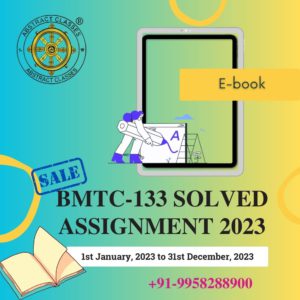
IGNOU BMTC-133 Solved Assignment 2023 | B.Sc (G) CBCS
₹101.00Please read the following points before ordering this IGNOU Assignment Solution.

IGNOU BMTC-132 Solved Assignment 2023 | B.Sc (G) CBCS
₹101.00Please read the following points before ordering this IGNOU Assignment Solution.

IGNOU BMTC-131 Solved Assignment 2023 | B.Sc (G) CBCS
₹101.00Please read the following points before ordering this IGNOU Assignment Solution.

IGNOU MTE-13 Solved Assignment 2023 | MTE
₹251.00Please read the following points before ordering this IGNOU Assignment Solution.

IGNOU MTE-12 Solved Assignment 2023 | MTE
₹251.00Please read the following points before ordering this IGNOU Assignment Solution.

IGNOU MTE-11 Solved Assignment 2023 | MTE
₹251.00Please read the following points before ordering this IGNOU Assignment Solution.

IGNOU MTE-10 Solved Assignment 2023 | MTE
₹201.00Please read the following points before ordering this IGNOU Assignment Solution.

IGNOU MTE-09 Solved Assignment 2023 | MTE
₹201.00Please read the following points before ordering this IGNOU Assignment Solution.

IGNOU MTE-08 Solved Assignment 2023 | MTE
₹201.00Please read the following points before ordering this IGNOU Assignment Solution.

IGNOU MTE-07 Solved Assignment 2023 | MTE
₹201.00Please read the following points before ordering this IGNOU Assignment Solution.

IGNOU MTE-06 Solved Assignment 2023 | MTE
₹151.00Please read the following points before ordering this IGNOU Assignment Solution.

IGNOU MTE-05 Solved Assignment 2023 | MTE
₹151.00Please read the following points before ordering this IGNOU Assignment Solution.
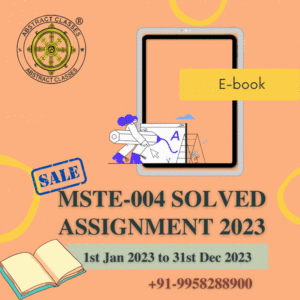
IGNOU MSTE-004 Solved Assignment 2023 | PGDAST
₹351.00Access via our Android App Only
Please read the following points before ordering :
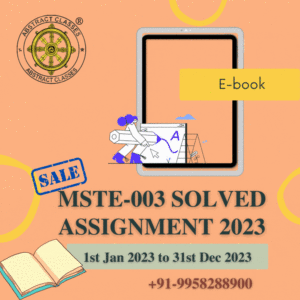
IGNOU MSTE-003 Solved Assignment 2023 | PGDAST
₹351.00Access via our Android App Only
Please read the following points before ordering :

IGNOU MSTE-002 Solved Assignment 2023 | PGDAST
₹351.00Access via our Android App Only
Please read the following points before ordering :

IGNOU MMT-001 Solved Assignment 2023 | MA MACS
₹351.00Access via our Android App Only
Please read the following points before ordering :
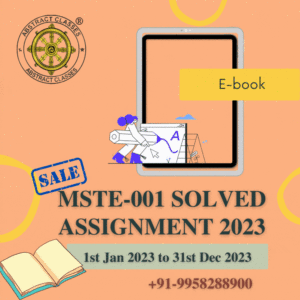
IGNOU MSTE-001 Solved Assignment 2023 | PGDAST
₹351.00Access via our Android App Only
Please read the following points before ordering :

IGNOU MST-005 Solved Assignment 2023 | PGDAST
₹351.00Access via our Android App Only
Please read the following points before ordering :

IGNOU BEVAE-181 Solved Assignment 2022-2023 | BSCG/ BAG/ BCOMG | AECC ON ENVIRONMENTAL STUDIES
₹51.00Please read the following points before ordering this IGNOU Assignment Solution.

IGNOU BEGC-133 Assignment Solution 2022-2023 | BAG | BRITISH LITERATURE
₹51.00Please read the following points before ordering this IGNOU Assignment Solution.

IGNOU BEGC-134 Assignment Solution 2022-2023 | BAG | Reading the Novel
₹51.00Please read the following points before ordering this IGNOU Assignment Solution.

IGNOU BEGLA-137 Assignment Solution 2022-2023 | BAG | Language through Literature
₹51.00Please read the following points before ordering this IGNOU Assignment Solution.

IGNOU BEGLA-138 Assignment Solution 2022-2023 | BAG | Reading & Speaking Skills
₹51.00Please read the following points before ordering this IGNOU Assignment Solution.

IGNOU BEGS-183 Assignment Solution 2022-2023 | BAG | WRITING AND STUDY SKILLS
₹51.00Please read the following points before ordering this IGNOU Assignment Solution.

IGNOU BSOC – 133 Solved Assignment 2022-2023 | BAG | SOCIOLOGICAL THEORIES
₹51.00Please read the following points before ordering this IGNOU Assignment Solution.

IGNOU BSOC – 134 Solved Assignment 2022-2023 | B.A.G | METHODS OF SOCIOLOGICAL ENQUIRY
₹51.00Please read the following points before ordering this IGNOU Assignment Solution.

IGNOU BCOS – 184 Solved Assignment 2022-2023 | B.Com | E-COMMERCE
₹51.00Please read the following points before ordering this IGNOU Assignment Solution.

IGNOU MPC-006 Solved Assignment 2022-2023 | MAPC | STATISTICS IN PSYCHOLOGY
₹101.00Please read the following points before ordering this IGNOU Assignment Solution.

IGNOU MPC-005 Solved Assignment 2022-2023 | MAPC | Research Methods
₹101.00Please read the following points before ordering this IGNOU Assignment Solution.

IGNOU MPC-004 Solved Assignment 2022-2023 | MAPC | ADVANCED SOCIAL PSYCHOLOGY
₹101.00Please read the following points before ordering this IGNOU Assignment Solution.

IGNOU MPC-003 Solved Assignment 2022-2023 | MAPC | PERSONALITY: THEORIES AND ASSESSMENT
₹101.00Please read the following points before ordering this IGNOU Assignment Solution.

IGNOU MPC-002 Solved Assignment 2022-2023 | MAPC | LIFE SPAN PSYCHOLOGY
₹101.00Please read the following points before ordering this IGNOU Assignment Solution.

IGNOU MPC-001 Solved Assignment 2022-2023 | MAPC | Cognitive Psychology, Learning and Memory
₹101.00Please read the following points before ordering this IGNOU Assignment Solution.

IGNOU MEG-19 Solved Assignment 2022-2023 | MEG | THE AUSTRALIAN NOVEL
₹101.00Please read the following points before ordering this IGNOU Assignment Solution.

IGNOU MEG-18 Solved Assignment 2022-2023 | MEG | American Poetry
₹101.00Please read the following points before ordering this IGNOU Assignment Solution.

IGNOU MEG-17 Solved Assignment 2022-2023 | MEG | American Drama
₹101.00Please read the following points before ordering this IGNOU Assignment Solution.

IGNOU MEG-16 Solved Assignment 2022-2023 | MEG | Indian Folk Literature
₹101.00Please read the following points before ordering this IGNOU Assignment Solution.

IGNOU MEG-15 Solved Assignment 2022-2023 | MEG | Comparative Literature: Theory and Practice
₹101.00Please read the following points before ordering this IGNOU Assignment Solution.

IGNOU MEG-14 Solved Assignment 2022-2023 | MEG | Contemporary Indian Literature in English Translation
₹101.00Please read the following points before ordering this IGNOU Assignment Solution.

IGNOU MEG-13 Solved Assignment 2022-2023 | MEG | WRITINGS FROM THE MARGINS
₹101.00Please read the following points before ordering this IGNOU Assignment Solution.

IGNOU MEG-12 Solved Assignment 2022-2023 | MEG | A Survey Course in 20th Century Canadian Literature
₹101.00Please read the following points before ordering this IGNOU Assignment Solution.

IGNOU MEG-11 Solved Assignment 2022-2023 | MEG | AMERICAN NOVEL
₹101.00Please read the following points before ordering this IGNOU Assignment Solution.

IGNOU MEG-10 Solved Assignment 2022-2023 | MEG | ENGLISH STUDIES IN INDIA
₹101.00Please read the following points before ordering this IGNOU Assignment Solution.

IGNOU MEG-09 Solved Assignment 2022-2023 | MEG | Australian Literature
₹101.00Please read the following points before ordering this IGNOU Assignment Solution.

IGNOU MEG-08 Solved Assignment 2022-2023 | MEG | NEW LITERATURES IN ENGLISH
₹101.00Please read the following points before ordering this IGNOU Assignment Solution.

IGNOU MEG-07 Solved Assignment 2022-2023 | MEG | INDIAN ENGLISH LITERATURE
₹101.00Please read the following points before ordering this IGNOU Assignment Solution.

IGNOU MEG-06 Solved Assignment 2022-2023 | MEG | AMERICAN LITERATURE
₹101.00Please read the following points before ordering this IGNOU Assignment Solution.

IGNOU MEG-05 Solved Assignment 2022-2023 | MEG | LITERARY CRITICISM & THEORY
₹101.00Please read the following points before ordering this IGNOU Assignment Solution.

IGNOU MEG-04 Solved Assignment 2022-2023 | MEG | ASPECTS OF LANGUAGE
₹101.00Please read the following points before ordering this IGNOU Assignment Solution.

IGNOU MEG-03 Solved Assignment 2022-2023 | MEG | British Novel
₹101.00Please read the following points before ordering this IGNOU Assignment Solution.

IGNOU MEG-02 Solved Assignment 2022-2023 | MEG | British Drama
₹101.00Please read the following points before ordering this IGNOU Assignment Solution.

IGNOU MEG-01 Solved Assignment 2022-2023 | MEG | British Poetry
₹101.00Please read the following points before ordering this IGNOU Assignment Solution.

IGNOU MST-004 Solved Assignment 2023 | PGDAST
₹351.00Access via our Android App Only
Please read the following points before ordering :

IGNOU MST-003 Solved Assignment 2023 | PGDAST
₹351.00Access via our Android App Only
Please read the following points before ordering :

IGNOU MST-002 Solved Assignment 2023 | PGDAST
₹351.00Access via our Android App Only
Please read the following points before ordering :

IGNOU MST-001 Solved Assignment 2023 | PGDAST
₹351.00Access via our Android App Only
Please read the following points before ordering :

Stop and Take a Second
₹110.00Donec pede justo, fringilla vel, aliquet nec, vulputate eget, arcu. In enim justo, rhoncus ut, imperdiet a, venenatis vitae, justo.
There are many variations of passages of Lorem Ipsum available, but the majority have suffered alteration in some form, by injected humour, or randomised words which don’t look even slightly.

Running From Me
₹70.00Donec pede justo, fringilla vel, aliquet nec, vulputate eget, arcu. In enim justo, rhoncus ut, imperdiet a, venenatis vitae, justo.
There are many variations of passages of Lorem Ipsum available, but the majority have suffered alteration in some form, by injected humour, or randomised words which don’t look even slightly.

Red Side Book
₹300.00Donec pede justo, fringilla vel, aliquet nec, vulputate eget, arcu. In enim justo, rhoncus ut, imperdiet a, venenatis vitae, justo.
There are many variations of passages of Lorem Ipsum available, but the majority have suffered alteration in some form, by injected humour, or randomised words which don’t look even slightly.

Real Life Fairytale
₹250.00Donec pede justo, fringilla vel, aliquet nec, vulputate eget, arcu. In enim justo, rhoncus ut, imperdiet a, venenatis vitae, justo.
There are many variations of passages of Lorem Ipsum available, but the majority have suffered alteration in some form, by injected humour, or randomised words which don’t look even slightly.

Note Book Mockup
₹200.00Donec pede justo, fringilla vel, aliquet nec, vulputate eget, arcu. In enim justo, rhoncus ut, imperdiet a, venenatis vitae, justo.
There are many variations of passages of Lorem Ipsum available, but the majority have suffered alteration in some form, by injected humour, or randomised words which don’t look even slightly.

Motivational Book Cover
This story, dazzling in its powerful simplicity and soul-stirring wisdom, is about an Andalusian shepherd boy named Santiago who travels from his homeland in Spain to the Egyptian desert in search of a treasure buried near the Pyramids. Lorem ipsum dolor sit amet, consectetur adipiscing elit, sed do eiusmod tempor incididunt ut labore et. Lorem ipsum dolor sit amet, consectetur adipiscing elit, sed do eiusmod tempor incididunt etc.
1 in stock

Book Cover Softcover
This story, dazzling in its powerful simplicity and soul-stirring wisdom, is about an Andalusian shepherd boy named Santiago who travels from his homeland in Spain to the Egyptian desert in search of a treasure buried near the Pyramids. Lorem ipsum dolor sit amet, consectetur adipiscing elit, sed do eiusmod tempor incididunt ut labore et. Lorem ipsum dolor sit amet, consectetur adipiscing elit, sed do eiusmod tempor incididunt etc.
4 in stock

IGNOU MSTE-004 Previous Year Paper Solution | PGDAST
₹365.00Solved Papers – Dec 2022 to Dec 2023 (Total 3 Papers)
Access via our Android App or any Web browser.
Please read the following points before ordering :

IGNOU MSTE-003 Previous Year Paper Solution | PGDAST
₹365.00Solved Papers – Dec 2022 to Dec 2023 (Total 3 Papers)
Access via our Android App or any Web browser.
Please read the following points before ordering :

IGNOU MSTE-002 Previous Year Paper Solution | PGDAST
₹365.00Solved Papers – June 2015 to Dec 2023 (Total 18 Papers)
Access via our Android App or any Web browser.
Please read the following points before ordering :

IGNOU MSTE-001 Previous Year Paper Solution | PGDAST
₹365.00Solved Papers – Dec 2015 to Dec 2023 (Total 17 Papers)
Access via our Android App or any Web browser.
Please read the following points before ordering :

IGNOU MST-004 Previous Year Paper Solution | PGDAST
₹365.00Solved Papers – June 2015 to Dec 2023 (Total 18 Papers)
Access via our Android App or any Web browser.
Please read the following points before ordering :

IGNOU MST-019 Solved Assignment 2024 | MSCAST | IGNOU
₹365.00Access via our Android App Only
Please read the following points before ordering :

IGNOU MST-018 Solved Assignment 2024 | MSCAST | IGNOU
₹365.00Access via our Android App Only
Please read the following points before ordering :

IGNOU MST-017 Solved Assignment 2024 | MSCAST | IGNOU
₹365.00Access via our Android App Only
Please read the following points before ordering :

IGNOU MST-016 Solved Assignment 2024 | MSCAST | IGNOU
₹365.00Access via our Android App Only
Please read the following points before ordering :

IGNOU MPH-005 Solved Assignment 2024 | MSCPH | IGNOU
₹365.00Access via our Android App Only
Please read the following points before ordering :

IGNOU MPH-004 Solved Assignment 2024 | MSCPH | IGNOU
₹365.00Access via our Android App Only
Please read the following points before ordering :

IGNOU MPH-003 Solved Assignment 2024 | MSCPH | IGNOU
₹365.00Access via our Android App Only
Please read the following points before ordering :

IGNOU MPH-002 Solved Assignment 2024 | MSCPH | IGNOU
₹365.00Access via our Android App Only
Please read the following points before ordering :

IGNOU MPH-001 Solved Assignment 2024 | MSCPH | IGNOU
₹365.00Access via our Android App Only
Please read the following points before ordering :

IGNOU BZYET-143 Solved Assignment 2024 | B.Sc. CBCS Zoology
₹49.00Please read the following points before ordering this IGNOU Assignment Solution.

IGNOU BZYET-141 Solved Assignment 2024 | B.Sc. CBCS Zoology
₹49.00Please read the following points before ordering this IGNOU Assignment Solution.

IGNOU BZYCT-137 Solved Assignment 2024 | B.Sc. CBCS Zoology
₹49.00Please read the following points before ordering this IGNOU Assignment Solution.

IGNOU BZYCT-135 Solved Assignment 2024 | B.Sc. CBCS Zoology
₹49.00Please read the following points before ordering this IGNOU Assignment Solution.

IGNOU MMT-007 Solved Assignment 2024 | M.Sc. MACS
₹365.00Access via our Android App Only
Please read the following points before ordering :

IGNOU MMT-005 Solved Assignment 2024 | M.Sc. MACS
₹365.00Access via our Android App Only
Please read the following points before ordering :

IGNOU MMT-004 Solved Assignment 2024 | M.Sc. MACS
₹365.00Access via our Android App Only
Please read the following points before ordering :

IGNOU MMT-002 Solved Assignment 2024 | M.Sc. MACS
₹365.00Access via our Android App Only
Please read the following points before ordering :

IGNOU MMT-001 Solved Assignment 2024 | M.Sc. MACS
₹365.00Access via our Android App Only
Please read the following points before ordering :

IGNOU MMT-008 Solved Assignment 2024 | M.Sc. MACS
₹365.00Access via our Android App Only
Please read the following points before ordering :

IGNOU MMTE-001 Solved Assignment 2024 | M.Sc. MACS
₹365.00Access via our Android App Only
Please read the following points before ordering :

IGNOU MMTE-002 Solved Assignment 2024 | M.Sc. MACS
₹365.00Access via our Android App Only
Please read the following points before ordering :

IGNOU MMT-009 Solved Assignment 2024 | M.Sc. MACS
₹365.00Access via our Android App Only
Please read the following points before ordering :

IGNOU MMTE-004 Solved Assignment 2024 | M.Sc. MACS
₹365.00Access via our Android App Only
Please read the following points before ordering :

IGNOU MMTE-003 Solved Assignment 2024 | M.Sc. MACS
₹365.00Access via our Android App Only
Please read the following points before ordering :

IGNOU MMT-006 Solved Assignment 2024 | M.Sc. MACS
₹365.00Access via our Android App Only
Please read the following points before ordering :

IGNOU MMT-003 Solved Assignment 2024 | M.Sc. MACS
₹365.00Access via our Android App Only
Please read the following points before ordering :

IGNOU BCHET-147 Solved Assignment 2024 | B.Sc. CBCS Chemistry
₹49.00Please read the following points before ordering this IGNOU Assignment Solution.

IGNOU BCHET-141 Solved Assignment 2024 | B.Sc. CBCS Chemistry
₹49.00Please read the following points before ordering this IGNOU Assignment Solution.

IGNOU BCHCT-137 Solved Assignment 2024 | B.Sc. CBCS Chemistry
₹49.00Please read the following points before ordering this IGNOU Assignment Solution.

IGNOU BCHCT-135 Solved Assignment 2024 | B.Sc. CBCS Chemistry
₹49.00Please read the following points before ordering this IGNOU Assignment Solution.

IGNOU BPHET-143 Solved Assignment 2024 | B.Sc (G) CBCS
₹101.00Please read the following points before ordering this IGNOU Assignment Solution.

IGNOU BPHET-141 Solved Assignment 2024 | B.Sc (G) CBCS
₹101.00Please read the following points before ordering this IGNOU Assignment Solution.

IGNOU BPHCT-137 Solved Assignment 2024 | B.Sc (G) CBCS
₹101.00Please read the following points before ordering this IGNOU Assignment Solution.

IGNOU BPHCT-135 Solved Assignment 2024 | B.Sc (G) CBCS
₹101.00Please read the following points before ordering this IGNOU Assignment Solution.

IGNOU BPHCT-133 Solved Assignment 2024 | B.Sc (G) CBCS
₹101.00Please read the following points before ordering this IGNOU Assignment Solution.

IGNOU BPHCT-131 Solved Assignment 2024 | B.Sc (G) CBCS
₹101.00Please read the following points before ordering this IGNOU Assignment Solution.

IGNOU BBYET-143 Solved Assignment 2024 | B.Sc. CBCS Botany
₹49.00Please read the following points before ordering this IGNOU Assignment Solution.

IGNOU BBYET-141 Solved Assignment 2024 | B.Sc. CBCS Botany
₹49.00Please read the following points before ordering this IGNOU Assignment Solution.

IGNOU BBYCT-137 Solved Assignment 2024 | B.Sc. CBCS Botany
₹49.00Please read the following points before ordering this IGNOU Assignment Solution.

IGNOU BBYCT-135 Solved Assignment 2024 | B.Sc. CBCS Botany
₹49.00Please read the following points before ordering this IGNOU Assignment Solution.

IGNOU BBYCT-133 Solved Assignment 2024 | B.Sc. CBCS Botany
₹49.00Please read the following points before ordering this IGNOU Assignment Solution.

IGNOU BBYCT-131 Solved Assignment 2024 | B.Sc. CBCS Botany
₹49.00Please read the following points before ordering this IGNOU Assignment Solution.

IGNOU BZYCT-133 Solved Assignment 2024 | B.Sc. CBCS Zoology
₹49.00Please read the following points before ordering this IGNOU Assignment Solution.

IGNOU BZYCT-131 Solved Assignment 2024 | B.Sc. CBCS Zoology
₹49.00Please read the following points before ordering this IGNOU Assignment Solution.

IGNOU BCHCT-133 Solved Assignment 2024 | B.Sc. CBCS Chemistry
₹49.00Please read the following points before ordering this IGNOU Assignment Solution.

IGNOU BCHCT-131 Solved Assignment 2024 | B.Sc. CBCS Chemistry
₹49.00Please read the following points before ordering this IGNOU Assignment Solution.

IGNOU BEGAE-182 Solved Assignment 2024 | CBCS
₹49.00Please read the following points before ordering this IGNOU Assignment Solution.

IGNOU BEVAE-181 Solved Assignment 2024 | B.Sc (G) CBCS AECC
₹49.00Please read the following points before ordering this IGNOU Assignment Solution.

IGNOU BMTC-132 Solved Assignment 2024 | B.Sc (G) CBCS
₹101.00Please read the following points before ordering this IGNOU Assignment Solution.

IGNOU BMTC-131 Solved Assignment 2024 | B.Sc (G) CBCS
₹101.00Please read the following points before ordering this IGNOU Assignment Solution.

IGNOU BMTC-133 Solved Assignment 2024 | B.Sc (G) CBCS
₹101.00Please read the following points before ordering this IGNOU Assignment Solution.

IGNOU BMTC-134 Solved Assignment 2024 | B.Sc (G) CBCS
₹101.00Please read the following points before ordering this IGNOU Assignment Solution.

IGNOU BMTE-144 Solved Assignment 2024 | B.Sc (G) CBCS
₹101.00Please read the following points before ordering this IGNOU Assignment Solution.

IGNOU BMTE-141 Solved Assignment 2024 | B.Sc (G) CBCS
₹101.00Please read the following points before ordering this IGNOU Assignment Solution.

IGNOU MSTE-004 Solved Assignment 2024 | PGDAST
₹351.00Access via our Android App Only
Please read the following points before ordering :

IGNOU MSTE-003 Solved Assignment 2024 | PGDAST
₹351.00Access via our Android App Only
Please read the following points before ordering :

IGNOU MSTE-002 Solved Assignment 2024 | PGDAST
₹351.00Access via our Android App Only
Please read the following points before ordering :

IGNOU MSTE-001 Solved Assignment 2024 | PGDAST
₹351.00Access via our Android App Only
Please read the following points before ordering :

IGNOU MST-005 Solved Assignment 2024 | PGDAST
₹351.00Access via our Android App Only
Please read the following points before ordering :

IGNOU MST-004 Solved Assignment 2024 | PGDAST
₹351.00Access via our Android App Only
Please read the following points before ordering :

IGNOU MST-003 Solved Assignment 2024 | PGDAST
₹351.00Access via our Android App Only
Please read the following points before ordering :

IGNOU MST-002 Solved Assignment 2024 | PGDAST
₹351.00Access via our Android App Only
Please read the following points before ordering :

IGNOU MST-001 Solved Assignment 2024 | PGDAST
₹351.00Access via our Android App Only
Please read the following points before ordering :

IGNOU MST-003 Previous Year Paper Solution | PGDAST
₹365.00Solved Papers – June 2015 to Dec 2023 (Total 18 Papers)
Access via our Android App or any Web browser.
Please read the following points before ordering :

IGNOU MST-005 Previous Year Paper Solution | PGDAST
₹365.00Solved Papers – Dec 2015 to Dec 2023 (Total 17 Papers)
Access via our Android App or any Web browser.
Please read the following points before ordering :

IGNOU MST-002 Previous Year Paper Solution | PGDAST
₹365.00Solved Papers – June 2015 to Dec 2023 (Total 18 Papers)
Access via our Android App or any Web browser.
Please read the following points before ordering :

IGNOU MMTE-001 Solved Assignment 2023 | M.Sc. MACS
₹365.00Access via our Android App Only
Please read the following points before ordering :

UPSC Previous Years Maths Optional Papers with Solution | Paper-02
₹1,095.00Available on our Android App as well.
Please read the following points before ordering :

UPSC Previous Years Maths Optional Papers with Solution | Paper-01
₹1,095.00Available on our Android App as well.
Please read the following points before ordering :

IGNOU MST-015 Solved Assignment 2023 | MSCAST
₹365.00Access via our Android App Only
Please read the following points before ordering :

IGNOU MST-014 Solved Assignment 2023 | MSCAST
₹365.00Access via our Android App Only
Please read the following points before ordering :

IGNOU MST-013 Solved Assignment 2023 | MSCAST
₹365.00Access via our Android App Only
Please read the following points before ordering :

IGNOU MST-012 Solved Assignment 2023 | MSCAST
₹365.00Access via our Android App Only
Please read the following points before ordering :

IGNOU MST-011 Solved Assignment 2023 | MSCAST
₹365.00Access via our Android App Only
Please read the following points before ordering :

IGNOU MMT-008 Solved Assignment 2023 | M.Sc. MACS
₹365.00Access via our Android App Only
Please read the following points before ordering :

IGNOU MMT-006 Solved Assignment 2023 | M.Sc. MACS
₹365.00Access via our Android App Only
Please read the following points before ordering :

IGNOU MMT-003 Solved Assignment 2023 | M.Sc. MACS
₹365.00Access via our Android App Only
Please read the following points before ordering :

IGNOU MST-001 Previous Year Paper Solution | PGDAST
₹365.00Solved Papers – June 2015 to Dec 2023 (Total 18 Papers)
Access via our Android App or any Web browser.
Please read the following points before ordering :

IGNOU MEV-019 Solved Assignment 2023-2024 | MSCENV
₹101.00Access via our Android App Only
Please read the following points before ordering :

IGNOU MEV-018 Solved Assignment 2023-2024 | MSCENV
₹101.00Access via our Android App Only
Please read the following points before ordering :

IGNOU MEV-017 Solved Assignment 2023-2024 | MSCENV
₹101.00Access via our Android App Only
Please read the following points before ordering :

IGNOU MEV-016 Solved Assignment 2023-2024 | MSCENV
₹101.00Access via our Android App Only
Please read the following points before ordering :

IGNOU MEV-015 Solved Assignment 2023-2024 | MSCENV
₹101.00Access via our Android App Only
Please read the following points before ordering :

IGNOU MEV-014 Solved Assignment 2023-2024 | MSCENV
₹101.00Access via our Android App Only
Please read the following points before ordering :

IGNOU MEV-013 Solved Assignment 2023-2024 | MSCENV
₹101.00Access via our Android App Only
Please read the following points before ordering :

IGNOU MEV-012 Solved Assignment 2023-2024 | MSCENV
₹101.00Access via our Android App Only
Please read the following points before ordering :

IGNOU MEV-011 Solved Assignment 2023-2024 | MSCENV
₹101.00Access via our Android App Only
Please read the following points before ordering :

IGNOU BCHET-149 Solved Assignment 2023 | B.Sc (G) CBCS
₹101.00Please read the following points before ordering this IGNOU Assignment Solution.

IGNOU BCHET-147 Solved Assignment 2023 | B.Sc (G) CBCS
₹101.00Please read the following points before ordering this IGNOU Assignment Solution.

IGNOU BCHET-141 Solved Assignment 2023 | B.Sc (G) CBCS
₹101.00Please read the following points before ordering this IGNOU Assignment Solution.

IGNOU BCHCT-137 Solved Assignment 2023 | B.Sc (G) CBCS
₹101.00Please read the following points before ordering this IGNOU Assignment Solution.

IGNOU BCHCT-135 Solved Assignment 2023 | B.Sc (G) CBCS
₹101.00Please read the following points before ordering this IGNOU Assignment Solution.

IGNOU BPHET-143 Solved Assignment 2023 | B.Sc. CBCS
₹101.00Access via our Android App Only
Please read the following points before ordering :

IGNOU BPHET-141 Solved Assignment 2023 | B.Sc. CBCS
₹101.00Access via our Android App Only
Please read the following points before ordering :

IGNOU BPHCT-137 Solved Assignment 2023 | B.Sc. CBCS
₹101.00Access via our Android App Only
Please read the following points before ordering :

IGNOU BPHCT-135 Solved Assignment 2023 | B.Sc. CBCS
₹101.00Access via our Android App Only
Please read the following points before ordering :

IGNOU BMTE-144 Solved Assignment 2023 | B.Sc (G) CBCS
₹101.00Please read the following points before ordering this IGNOU Assignment Solution.

IGNOU MEG-19 Solved Assignment 2023-2024 | MA MEG
₹101.00Access via our Android App Only
Please read the following points before ordering :

IGNOU MEG-18 Solved Assignment 2023-2024 | MA MEG
₹101.00Access via our Android App Only
Please read the following points before ordering :

IGNOU MEG-17 Solved Assignment 2023-2024 | MA MEG
₹101.00Access via our Android App Only
Please read the following points before ordering :

IGNOU MEG-16 Solved Assignment 2023-2024 | MA MEG
₹101.00Access via our Android App Only
Please read the following points before ordering :

IGNOU MEG-15 Solved Assignment 2023-2024 | MA MEG
₹101.00Access via our Android App Only
Please read the following points before ordering :

IGNOU MEG-14 Solved Assignment 2023-2024 | MA MEG
₹101.00Access via our Android App Only
Please read the following points before ordering :

IGNOU MEG-13 Solved Assignment 2023-2024 | MA MEG
₹101.00Access via our Android App Only
Please read the following points before ordering :

IGNOU MEG-12 Solved Assignment 2023-2024 | MA MEG
₹101.00Access via our Android App Only
Please read the following points before ordering :

IGNOU MEG-11 Solved Assignment 2023-2024 | MA MEG
₹101.00Access via our Android App Only
Please read the following points before ordering :

IGNOU MEG-10 Solved Assignment 2023-2024 | MA MEG
₹101.00Access via our Android App Only
Please read the following points before ordering :

IGNOU MEG-09 Solved Assignment 2023-2024 | MA MEG
₹101.00Access via our Android App Only
Please read the following points before ordering :

IGNOU MEG-08 Solved Assignment 2023-2024 | MA MEG
₹101.00Access via our Android App Only
Please read the following points before ordering :

IGNOU MEG-07 Solved Assignment 2023-2024 | MA MEG
₹101.00Access via our Android App Only
Please read the following points before ordering :

IGNOU MEG-06 Solved Assignment 2023-2024 | MA MEG
₹101.00Access via our Android App Only
Please read the following points before ordering :

IGNOU MEG-05 Solved Assignment 2023-2024 | MA MEG
₹101.00Access via our Android App Only
Please read the following points before ordering :

IGNOU MEG-04 Solved Assignment 2023-2024 | MA MEG
₹101.00Access via our Android App Only
Please read the following points before ordering :

IGNOU MEG-03 Solved Assignment 2023-2024 | MA MEG
₹101.00Access via our Android App Only
Please read the following points before ordering :

IGNOU MEG-02 Solved Assignment 2023-2024 | MA MEG
₹101.00Access via our Android App Only
Please read the following points before ordering :

IGNOU MEG-01 Solved Assignment 2023-2024 | MA MEG
₹101.00Access via our Android App Only
Please read the following points before ordering :

IGNOU MMT-007 Solved Assignment 2023 | M.Sc. MACS
₹351.00Access via our Android App Only
Please read the following points before ordering :

IGNOU MMT-005 Solved Assignment 2023 | M.Sc. MACS
₹351.00Access via our Android App Only
Please read the following points before ordering :

IGNOU MMT-004 Solved Assignment 2023 | M.Sc. MACS
₹351.00Access via our Android App Only
Please read the following points before ordering :

IGNOU MMT-002 Solved Assignment 2023 | M.Sc. MACS
₹351.00Access via our Android App Only
Please read the following points before ordering :

IGNOU MSTL-002 Solved Assignment 2023 | PGDAST
₹401.00Access via our Android App Only
Please read the following points before ordering :

IGNOU MSTL-001 Solved Assignment 2023 | PGDAST
₹401.00Access via our Android App Only
Please read the following points before ordering :

IGNOU PHE-06 Solved Assignment 2023
₹201.00Please read the following points before ordering this IGNOU Assignment Solution.

IGNOU BCHCT-133 Solved Assignment 2023 | B.Sc (G) CBCS
₹101.00Please read the following points before ordering this IGNOU Assignment Solution.

IGNOU BCHCT-131 Solved Assignment 2023 | B.Sc (G) CBCS
₹101.00Please read the following points before ordering this IGNOU Assignment Solution.

IGNOU BPHCT-133 Solved Assignment 2023 | B.Sc (G) CBCS
₹101.00Please read the following points before ordering this IGNOU Assignment Solution.

IGNOU BPHCT-131 Solved Assignment 2023 | B.Sc (G) CBCS
₹101.00Please read the following points before ordering this IGNOU Assignment Solution.

IGNOU BMTE-141 Solved Assignment 2023 | B.Sc (G) CBCS
₹101.00Please read the following points before ordering this IGNOU Assignment Solution.

IGNOU BMTC-134 Solved Assignment 2023 | B.Sc (G) CBCS
₹101.00Please read the following points before ordering this IGNOU Assignment Solution.

IGNOU BMTC-133 Solved Assignment 2023 | B.Sc (G) CBCS
₹101.00Please read the following points before ordering this IGNOU Assignment Solution.

IGNOU BMTC-132 Solved Assignment 2023 | B.Sc (G) CBCS
₹101.00Please read the following points before ordering this IGNOU Assignment Solution.

IGNOU BMTC-131 Solved Assignment 2023 | B.Sc (G) CBCS
₹101.00Please read the following points before ordering this IGNOU Assignment Solution.

IGNOU MTE-13 Solved Assignment 2023 | MTE
₹251.00Please read the following points before ordering this IGNOU Assignment Solution.

IGNOU MTE-12 Solved Assignment 2023 | MTE
₹251.00Please read the following points before ordering this IGNOU Assignment Solution.

IGNOU MTE-11 Solved Assignment 2023 | MTE
₹251.00Please read the following points before ordering this IGNOU Assignment Solution.

IGNOU MTE-10 Solved Assignment 2023 | MTE
₹201.00Please read the following points before ordering this IGNOU Assignment Solution.

IGNOU MTE-09 Solved Assignment 2023 | MTE
₹201.00Please read the following points before ordering this IGNOU Assignment Solution.

IGNOU MTE-08 Solved Assignment 2023 | MTE
₹201.00Please read the following points before ordering this IGNOU Assignment Solution.

IGNOU MTE-07 Solved Assignment 2023 | MTE
₹201.00Please read the following points before ordering this IGNOU Assignment Solution.

IGNOU MTE-06 Solved Assignment 2023 | MTE
₹151.00Please read the following points before ordering this IGNOU Assignment Solution.

IGNOU MTE-05 Solved Assignment 2023 | MTE
₹151.00Please read the following points before ordering this IGNOU Assignment Solution.

IGNOU MSTE-004 Solved Assignment 2023 | PGDAST
₹351.00Access via our Android App Only
Please read the following points before ordering :

IGNOU MSTE-003 Solved Assignment 2023 | PGDAST
₹351.00Access via our Android App Only
Please read the following points before ordering :

IGNOU MSTE-002 Solved Assignment 2023 | PGDAST
₹351.00Access via our Android App Only
Please read the following points before ordering :

IGNOU MMT-001 Solved Assignment 2023 | MA MACS
₹351.00Access via our Android App Only
Please read the following points before ordering :

IGNOU MSTE-001 Solved Assignment 2023 | PGDAST
₹351.00Access via our Android App Only
Please read the following points before ordering :

IGNOU MST-005 Solved Assignment 2023 | PGDAST
₹351.00Access via our Android App Only
Please read the following points before ordering :

IGNOU BEVAE-181 Solved Assignment 2022-2023 | BSCG/ BAG/ BCOMG | AECC ON ENVIRONMENTAL STUDIES
₹51.00Please read the following points before ordering this IGNOU Assignment Solution.

IGNOU BEGC-133 Assignment Solution 2022-2023 | BAG | BRITISH LITERATURE
₹51.00Please read the following points before ordering this IGNOU Assignment Solution.

IGNOU BEGC-134 Assignment Solution 2022-2023 | BAG | Reading the Novel
₹51.00Please read the following points before ordering this IGNOU Assignment Solution.

IGNOU BEGLA-137 Assignment Solution 2022-2023 | BAG | Language through Literature
₹51.00Please read the following points before ordering this IGNOU Assignment Solution.

IGNOU BEGLA-138 Assignment Solution 2022-2023 | BAG | Reading & Speaking Skills
₹51.00Please read the following points before ordering this IGNOU Assignment Solution.

IGNOU BEGS-183 Assignment Solution 2022-2023 | BAG | WRITING AND STUDY SKILLS
₹51.00Please read the following points before ordering this IGNOU Assignment Solution.

IGNOU BSOC – 133 Solved Assignment 2022-2023 | BAG | SOCIOLOGICAL THEORIES
₹51.00Please read the following points before ordering this IGNOU Assignment Solution.

IGNOU BSOC – 134 Solved Assignment 2022-2023 | B.A.G | METHODS OF SOCIOLOGICAL ENQUIRY
₹51.00Please read the following points before ordering this IGNOU Assignment Solution.

IGNOU BCOS – 184 Solved Assignment 2022-2023 | B.Com | E-COMMERCE
₹51.00Please read the following points before ordering this IGNOU Assignment Solution.

IGNOU MPC-006 Solved Assignment 2022-2023 | MAPC | STATISTICS IN PSYCHOLOGY
₹101.00Please read the following points before ordering this IGNOU Assignment Solution.

IGNOU MPC-005 Solved Assignment 2022-2023 | MAPC | Research Methods
₹101.00Please read the following points before ordering this IGNOU Assignment Solution.

IGNOU MPC-004 Solved Assignment 2022-2023 | MAPC | ADVANCED SOCIAL PSYCHOLOGY
₹101.00Please read the following points before ordering this IGNOU Assignment Solution.

IGNOU MPC-003 Solved Assignment 2022-2023 | MAPC | PERSONALITY: THEORIES AND ASSESSMENT
₹101.00Please read the following points before ordering this IGNOU Assignment Solution.

IGNOU MPC-002 Solved Assignment 2022-2023 | MAPC | LIFE SPAN PSYCHOLOGY
₹101.00Please read the following points before ordering this IGNOU Assignment Solution.

IGNOU MPC-001 Solved Assignment 2022-2023 | MAPC | Cognitive Psychology, Learning and Memory
₹101.00Please read the following points before ordering this IGNOU Assignment Solution.

IGNOU MEG-19 Solved Assignment 2022-2023 | MEG | THE AUSTRALIAN NOVEL
₹101.00Please read the following points before ordering this IGNOU Assignment Solution.

IGNOU MEG-18 Solved Assignment 2022-2023 | MEG | American Poetry
₹101.00Please read the following points before ordering this IGNOU Assignment Solution.

IGNOU MEG-17 Solved Assignment 2022-2023 | MEG | American Drama
₹101.00Please read the following points before ordering this IGNOU Assignment Solution.

IGNOU MEG-16 Solved Assignment 2022-2023 | MEG | Indian Folk Literature
₹101.00Please read the following points before ordering this IGNOU Assignment Solution.

IGNOU MEG-15 Solved Assignment 2022-2023 | MEG | Comparative Literature: Theory and Practice
₹101.00Please read the following points before ordering this IGNOU Assignment Solution.

IGNOU MEG-14 Solved Assignment 2022-2023 | MEG | Contemporary Indian Literature in English Translation
₹101.00Please read the following points before ordering this IGNOU Assignment Solution.

IGNOU MEG-13 Solved Assignment 2022-2023 | MEG | WRITINGS FROM THE MARGINS
₹101.00Please read the following points before ordering this IGNOU Assignment Solution.

IGNOU MEG-12 Solved Assignment 2022-2023 | MEG | A Survey Course in 20th Century Canadian Literature
₹101.00Please read the following points before ordering this IGNOU Assignment Solution.

IGNOU MEG-11 Solved Assignment 2022-2023 | MEG | AMERICAN NOVEL
₹101.00Please read the following points before ordering this IGNOU Assignment Solution.

IGNOU MEG-10 Solved Assignment 2022-2023 | MEG | ENGLISH STUDIES IN INDIA
₹101.00Please read the following points before ordering this IGNOU Assignment Solution.

IGNOU MEG-09 Solved Assignment 2022-2023 | MEG | Australian Literature
₹101.00Please read the following points before ordering this IGNOU Assignment Solution.

IGNOU MEG-08 Solved Assignment 2022-2023 | MEG | NEW LITERATURES IN ENGLISH
₹101.00Please read the following points before ordering this IGNOU Assignment Solution.

IGNOU MEG-07 Solved Assignment 2022-2023 | MEG | INDIAN ENGLISH LITERATURE
₹101.00Please read the following points before ordering this IGNOU Assignment Solution.

IGNOU MEG-06 Solved Assignment 2022-2023 | MEG | AMERICAN LITERATURE
₹101.00Please read the following points before ordering this IGNOU Assignment Solution.

IGNOU MEG-05 Solved Assignment 2022-2023 | MEG | LITERARY CRITICISM & THEORY
₹101.00Please read the following points before ordering this IGNOU Assignment Solution.

IGNOU MEG-04 Solved Assignment 2022-2023 | MEG | ASPECTS OF LANGUAGE
₹101.00Please read the following points before ordering this IGNOU Assignment Solution.

IGNOU MEG-03 Solved Assignment 2022-2023 | MEG | British Novel
₹101.00Please read the following points before ordering this IGNOU Assignment Solution.

IGNOU MEG-02 Solved Assignment 2022-2023 | MEG | British Drama
₹101.00Please read the following points before ordering this IGNOU Assignment Solution.

IGNOU MEG-01 Solved Assignment 2022-2023 | MEG | British Poetry
₹101.00Please read the following points before ordering this IGNOU Assignment Solution.

IGNOU MST-004 Solved Assignment 2023 | PGDAST
₹351.00Access via our Android App Only
Please read the following points before ordering :

IGNOU MST-003 Solved Assignment 2023 | PGDAST
₹351.00Access via our Android App Only
Please read the following points before ordering :

IGNOU MST-002 Solved Assignment 2023 | PGDAST
₹351.00Access via our Android App Only
Please read the following points before ordering :

IGNOU MST-001 Solved Assignment 2023 | PGDAST
₹351.00Access via our Android App Only
Please read the following points before ordering :

Stop and Take a Second
₹110.00Donec pede justo, fringilla vel, aliquet nec, vulputate eget, arcu. In enim justo, rhoncus ut, imperdiet a, venenatis vitae, justo.
There are many variations of passages of Lorem Ipsum available, but the majority have suffered alteration in some form, by injected humour, or randomised words which don’t look even slightly.

Running From Me
₹70.00Donec pede justo, fringilla vel, aliquet nec, vulputate eget, arcu. In enim justo, rhoncus ut, imperdiet a, venenatis vitae, justo.
There are many variations of passages of Lorem Ipsum available, but the majority have suffered alteration in some form, by injected humour, or randomised words which don’t look even slightly.

Red Side Book
₹300.00Donec pede justo, fringilla vel, aliquet nec, vulputate eget, arcu. In enim justo, rhoncus ut, imperdiet a, venenatis vitae, justo.
There are many variations of passages of Lorem Ipsum available, but the majority have suffered alteration in some form, by injected humour, or randomised words which don’t look even slightly.

Real Life Fairytale
₹250.00Donec pede justo, fringilla vel, aliquet nec, vulputate eget, arcu. In enim justo, rhoncus ut, imperdiet a, venenatis vitae, justo.
There are many variations of passages of Lorem Ipsum available, but the majority have suffered alteration in some form, by injected humour, or randomised words which don’t look even slightly.

Note Book Mockup
₹200.00Donec pede justo, fringilla vel, aliquet nec, vulputate eget, arcu. In enim justo, rhoncus ut, imperdiet a, venenatis vitae, justo.
There are many variations of passages of Lorem Ipsum available, but the majority have suffered alteration in some form, by injected humour, or randomised words which don’t look even slightly.

Motivational Book Cover
This story, dazzling in its powerful simplicity and soul-stirring wisdom, is about an Andalusian shepherd boy named Santiago who travels from his homeland in Spain to the Egyptian desert in search of a treasure buried near the Pyramids. Lorem ipsum dolor sit amet, consectetur adipiscing elit, sed do eiusmod tempor incididunt ut labore et. Lorem ipsum dolor sit amet, consectetur adipiscing elit, sed do eiusmod tempor incididunt etc.
1 in stock

Book Cover Softcover
This story, dazzling in its powerful simplicity and soul-stirring wisdom, is about an Andalusian shepherd boy named Santiago who travels from his homeland in Spain to the Egyptian desert in search of a treasure buried near the Pyramids. Lorem ipsum dolor sit amet, consectetur adipiscing elit, sed do eiusmod tempor incididunt ut labore et. Lorem ipsum dolor sit amet, consectetur adipiscing elit, sed do eiusmod tempor incididunt etc.
4 in stock

IGNOU MSTE-004 Previous Year Paper Solution | PGDAST
₹365.00Solved Papers – Dec 2022 to Dec 2023 (Total 3 Papers)
Access via our Android App or any Web browser.
Please read the following points before ordering :

IGNOU MSTE-003 Previous Year Paper Solution | PGDAST
₹365.00Solved Papers – Dec 2022 to Dec 2023 (Total 3 Papers)
Access via our Android App or any Web browser.
Please read the following points before ordering :

IGNOU MSTE-002 Previous Year Paper Solution | PGDAST
₹365.00Solved Papers – June 2015 to Dec 2023 (Total 18 Papers)
Access via our Android App or any Web browser.
Please read the following points before ordering :

IGNOU MSTE-001 Previous Year Paper Solution | PGDAST
₹365.00Solved Papers – Dec 2015 to Dec 2023 (Total 17 Papers)
Access via our Android App or any Web browser.
Please read the following points before ordering :

IGNOU MST-004 Previous Year Paper Solution | PGDAST
₹365.00Solved Papers – June 2015 to Dec 2023 (Total 18 Papers)
Access via our Android App or any Web browser.
Please read the following points before ordering :

IGNOU MST-019 Solved Assignment 2024 | MSCAST | IGNOU
₹365.00Access via our Android App Only
Please read the following points before ordering :

IGNOU MST-018 Solved Assignment 2024 | MSCAST | IGNOU
₹365.00Access via our Android App Only
Please read the following points before ordering :

IGNOU MST-017 Solved Assignment 2024 | MSCAST | IGNOU
₹365.00Access via our Android App Only
Please read the following points before ordering :

IGNOU MST-016 Solved Assignment 2024 | MSCAST | IGNOU
₹365.00Access via our Android App Only
Please read the following points before ordering :

IGNOU MPH-005 Solved Assignment 2024 | MSCPH | IGNOU
₹365.00Access via our Android App Only
Please read the following points before ordering :

IGNOU MPH-004 Solved Assignment 2024 | MSCPH | IGNOU
₹365.00Access via our Android App Only
Please read the following points before ordering :

IGNOU MPH-003 Solved Assignment 2024 | MSCPH | IGNOU
₹365.00Access via our Android App Only
Please read the following points before ordering :

IGNOU MPH-002 Solved Assignment 2024 | MSCPH | IGNOU
₹365.00Access via our Android App Only
Please read the following points before ordering :

IGNOU MPH-001 Solved Assignment 2024 | MSCPH | IGNOU
₹365.00Access via our Android App Only
Please read the following points before ordering :

IGNOU BZYET-143 Solved Assignment 2024 | B.Sc. CBCS Zoology
₹49.00Please read the following points before ordering this IGNOU Assignment Solution.

IGNOU BZYET-141 Solved Assignment 2024 | B.Sc. CBCS Zoology
₹49.00Please read the following points before ordering this IGNOU Assignment Solution.

IGNOU BZYCT-137 Solved Assignment 2024 | B.Sc. CBCS Zoology
₹49.00Please read the following points before ordering this IGNOU Assignment Solution.

IGNOU BZYCT-135 Solved Assignment 2024 | B.Sc. CBCS Zoology
₹49.00Please read the following points before ordering this IGNOU Assignment Solution.

IGNOU MMT-007 Solved Assignment 2024 | M.Sc. MACS
₹365.00Access via our Android App Only
Please read the following points before ordering :

IGNOU MMT-005 Solved Assignment 2024 | M.Sc. MACS
₹365.00Access via our Android App Only
Please read the following points before ordering :

IGNOU MMT-004 Solved Assignment 2024 | M.Sc. MACS
₹365.00Access via our Android App Only
Please read the following points before ordering :

IGNOU MMT-002 Solved Assignment 2024 | M.Sc. MACS
₹365.00Access via our Android App Only
Please read the following points before ordering :

IGNOU MMT-001 Solved Assignment 2024 | M.Sc. MACS
₹365.00Access via our Android App Only
Please read the following points before ordering :

IGNOU MMT-008 Solved Assignment 2024 | M.Sc. MACS
₹365.00Access via our Android App Only
Please read the following points before ordering :

IGNOU MMTE-001 Solved Assignment 2024 | M.Sc. MACS
₹365.00Access via our Android App Only
Please read the following points before ordering :

IGNOU MMTE-002 Solved Assignment 2024 | M.Sc. MACS
₹365.00Access via our Android App Only
Please read the following points before ordering :

IGNOU MMT-009 Solved Assignment 2024 | M.Sc. MACS
₹365.00Access via our Android App Only
Please read the following points before ordering :

IGNOU MMTE-004 Solved Assignment 2024 | M.Sc. MACS
₹365.00Access via our Android App Only
Please read the following points before ordering :

IGNOU MMTE-003 Solved Assignment 2024 | M.Sc. MACS
₹365.00Access via our Android App Only
Please read the following points before ordering :

IGNOU MMT-006 Solved Assignment 2024 | M.Sc. MACS
₹365.00Access via our Android App Only
Please read the following points before ordering :

IGNOU MMT-003 Solved Assignment 2024 | M.Sc. MACS
₹365.00Access via our Android App Only
Please read the following points before ordering :

IGNOU BCHET-147 Solved Assignment 2024 | B.Sc. CBCS Chemistry
₹49.00Please read the following points before ordering this IGNOU Assignment Solution.

IGNOU BCHET-141 Solved Assignment 2024 | B.Sc. CBCS Chemistry
₹49.00Please read the following points before ordering this IGNOU Assignment Solution.

IGNOU BCHCT-137 Solved Assignment 2024 | B.Sc. CBCS Chemistry
₹49.00Please read the following points before ordering this IGNOU Assignment Solution.

IGNOU BCHCT-135 Solved Assignment 2024 | B.Sc. CBCS Chemistry
₹49.00Please read the following points before ordering this IGNOU Assignment Solution.

IGNOU BPHET-143 Solved Assignment 2024 | B.Sc (G) CBCS
₹101.00Please read the following points before ordering this IGNOU Assignment Solution.

IGNOU BPHET-141 Solved Assignment 2024 | B.Sc (G) CBCS
₹101.00Please read the following points before ordering this IGNOU Assignment Solution.

IGNOU BPHCT-137 Solved Assignment 2024 | B.Sc (G) CBCS
₹101.00Please read the following points before ordering this IGNOU Assignment Solution.

IGNOU BPHCT-135 Solved Assignment 2024 | B.Sc (G) CBCS
₹101.00Please read the following points before ordering this IGNOU Assignment Solution.

IGNOU BPHCT-133 Solved Assignment 2024 | B.Sc (G) CBCS
₹101.00Please read the following points before ordering this IGNOU Assignment Solution.

IGNOU BPHCT-131 Solved Assignment 2024 | B.Sc (G) CBCS
₹101.00Please read the following points before ordering this IGNOU Assignment Solution.

IGNOU BBYET-143 Solved Assignment 2024 | B.Sc. CBCS Botany
₹49.00Please read the following points before ordering this IGNOU Assignment Solution.

IGNOU BBYET-141 Solved Assignment 2024 | B.Sc. CBCS Botany
₹49.00Please read the following points before ordering this IGNOU Assignment Solution.

IGNOU BBYCT-137 Solved Assignment 2024 | B.Sc. CBCS Botany
₹49.00Please read the following points before ordering this IGNOU Assignment Solution.

IGNOU BBYCT-135 Solved Assignment 2024 | B.Sc. CBCS Botany
₹49.00Please read the following points before ordering this IGNOU Assignment Solution.

IGNOU BBYCT-133 Solved Assignment 2024 | B.Sc. CBCS Botany
₹49.00Please read the following points before ordering this IGNOU Assignment Solution.

IGNOU BBYCT-131 Solved Assignment 2024 | B.Sc. CBCS Botany
₹49.00Please read the following points before ordering this IGNOU Assignment Solution.

IGNOU BZYCT-133 Solved Assignment 2024 | B.Sc. CBCS Zoology
₹49.00Please read the following points before ordering this IGNOU Assignment Solution.

IGNOU BZYCT-131 Solved Assignment 2024 | B.Sc. CBCS Zoology
₹49.00Please read the following points before ordering this IGNOU Assignment Solution.

IGNOU BCHCT-133 Solved Assignment 2024 | B.Sc. CBCS Chemistry
₹49.00Please read the following points before ordering this IGNOU Assignment Solution.

IGNOU BCHCT-131 Solved Assignment 2024 | B.Sc. CBCS Chemistry
₹49.00Please read the following points before ordering this IGNOU Assignment Solution.

IGNOU BEGAE-182 Solved Assignment 2024 | CBCS
₹49.00Please read the following points before ordering this IGNOU Assignment Solution.

IGNOU BEVAE-181 Solved Assignment 2024 | B.Sc (G) CBCS AECC
₹49.00Please read the following points before ordering this IGNOU Assignment Solution.

IGNOU BMTC-132 Solved Assignment 2024 | B.Sc (G) CBCS
₹101.00Please read the following points before ordering this IGNOU Assignment Solution.

IGNOU BMTC-131 Solved Assignment 2024 | B.Sc (G) CBCS
₹101.00Please read the following points before ordering this IGNOU Assignment Solution.

IGNOU BMTC-133 Solved Assignment 2024 | B.Sc (G) CBCS
₹101.00Please read the following points before ordering this IGNOU Assignment Solution.

IGNOU BMTC-134 Solved Assignment 2024 | B.Sc (G) CBCS
₹101.00Please read the following points before ordering this IGNOU Assignment Solution.

IGNOU BMTE-144 Solved Assignment 2024 | B.Sc (G) CBCS
₹101.00Please read the following points before ordering this IGNOU Assignment Solution.

IGNOU BMTE-141 Solved Assignment 2024 | B.Sc (G) CBCS
₹101.00Please read the following points before ordering this IGNOU Assignment Solution.

IGNOU MSTE-004 Solved Assignment 2024 | PGDAST
₹351.00Access via our Android App Only
Please read the following points before ordering :

IGNOU MSTE-003 Solved Assignment 2024 | PGDAST
₹351.00Access via our Android App Only
Please read the following points before ordering :

IGNOU MSTE-002 Solved Assignment 2024 | PGDAST
₹351.00Access via our Android App Only
Please read the following points before ordering :

IGNOU MSTE-001 Solved Assignment 2024 | PGDAST
₹351.00Access via our Android App Only
Please read the following points before ordering :

IGNOU MST-005 Solved Assignment 2024 | PGDAST
₹351.00Access via our Android App Only
Please read the following points before ordering :

IGNOU MST-004 Solved Assignment 2024 | PGDAST
₹351.00Access via our Android App Only
Please read the following points before ordering :

IGNOU MST-003 Solved Assignment 2024 | PGDAST
₹351.00Access via our Android App Only
Please read the following points before ordering :

IGNOU MST-002 Solved Assignment 2024 | PGDAST
₹351.00Access via our Android App Only
Please read the following points before ordering :

IGNOU MST-001 Solved Assignment 2024 | PGDAST
₹351.00Access via our Android App Only
Please read the following points before ordering :

IGNOU MST-003 Previous Year Paper Solution | PGDAST
₹365.00Solved Papers – June 2015 to Dec 2023 (Total 18 Papers)
Access via our Android App or any Web browser.
Please read the following points before ordering :

IGNOU MST-005 Previous Year Paper Solution | PGDAST
₹365.00Solved Papers – Dec 2015 to Dec 2023 (Total 17 Papers)
Access via our Android App or any Web browser.
Please read the following points before ordering :

IGNOU MST-002 Previous Year Paper Solution | PGDAST
₹365.00Solved Papers – June 2015 to Dec 2023 (Total 18 Papers)
Access via our Android App or any Web browser.
Please read the following points before ordering :

IGNOU MMTE-001 Solved Assignment 2023 | M.Sc. MACS
₹365.00Access via our Android App Only
Please read the following points before ordering :

UPSC Previous Years Maths Optional Papers with Solution | Paper-02
₹1,095.00Available on our Android App as well.
Please read the following points before ordering :

UPSC Previous Years Maths Optional Papers with Solution | Paper-01
₹1,095.00Available on our Android App as well.
Please read the following points before ordering :

IGNOU MST-015 Solved Assignment 2023 | MSCAST
₹365.00Access via our Android App Only
Please read the following points before ordering :

IGNOU MST-014 Solved Assignment 2023 | MSCAST
₹365.00Access via our Android App Only
Please read the following points before ordering :

IGNOU MST-013 Solved Assignment 2023 | MSCAST
₹365.00Access via our Android App Only
Please read the following points before ordering :

IGNOU MST-012 Solved Assignment 2023 | MSCAST
₹365.00Access via our Android App Only
Please read the following points before ordering :

IGNOU MST-011 Solved Assignment 2023 | MSCAST
₹365.00Access via our Android App Only
Please read the following points before ordering :

IGNOU MMT-008 Solved Assignment 2023 | M.Sc. MACS
₹365.00Access via our Android App Only
Please read the following points before ordering :

IGNOU MMT-006 Solved Assignment 2023 | M.Sc. MACS
₹365.00Access via our Android App Only
Please read the following points before ordering :

IGNOU MMT-003 Solved Assignment 2023 | M.Sc. MACS
₹365.00Access via our Android App Only
Please read the following points before ordering :

IGNOU MST-001 Previous Year Paper Solution | PGDAST
₹365.00Solved Papers – June 2015 to Dec 2023 (Total 18 Papers)
Access via our Android App or any Web browser.
Please read the following points before ordering :

IGNOU MEV-019 Solved Assignment 2023-2024 | MSCENV
₹101.00Access via our Android App Only
Please read the following points before ordering :

IGNOU MEV-018 Solved Assignment 2023-2024 | MSCENV
₹101.00Access via our Android App Only
Please read the following points before ordering :

IGNOU MEV-017 Solved Assignment 2023-2024 | MSCENV
₹101.00Access via our Android App Only
Please read the following points before ordering :

IGNOU MEV-016 Solved Assignment 2023-2024 | MSCENV
₹101.00Access via our Android App Only
Please read the following points before ordering :

IGNOU MEV-015 Solved Assignment 2023-2024 | MSCENV
₹101.00Access via our Android App Only
Please read the following points before ordering :

IGNOU MEV-014 Solved Assignment 2023-2024 | MSCENV
₹101.00Access via our Android App Only
Please read the following points before ordering :

IGNOU MEV-013 Solved Assignment 2023-2024 | MSCENV
₹101.00Access via our Android App Only
Please read the following points before ordering :

IGNOU MEV-012 Solved Assignment 2023-2024 | MSCENV
₹101.00Access via our Android App Only
Please read the following points before ordering :

IGNOU MEV-011 Solved Assignment 2023-2024 | MSCENV
₹101.00Access via our Android App Only
Please read the following points before ordering :

IGNOU BCHET-149 Solved Assignment 2023 | B.Sc (G) CBCS
₹101.00Please read the following points before ordering this IGNOU Assignment Solution.

IGNOU BCHET-147 Solved Assignment 2023 | B.Sc (G) CBCS
₹101.00Please read the following points before ordering this IGNOU Assignment Solution.

IGNOU BCHET-141 Solved Assignment 2023 | B.Sc (G) CBCS
₹101.00Please read the following points before ordering this IGNOU Assignment Solution.

IGNOU BCHCT-137 Solved Assignment 2023 | B.Sc (G) CBCS
₹101.00Please read the following points before ordering this IGNOU Assignment Solution.

IGNOU BCHCT-135 Solved Assignment 2023 | B.Sc (G) CBCS
₹101.00Please read the following points before ordering this IGNOU Assignment Solution.

IGNOU BPHET-143 Solved Assignment 2023 | B.Sc. CBCS
₹101.00Access via our Android App Only
Please read the following points before ordering :

IGNOU BPHET-141 Solved Assignment 2023 | B.Sc. CBCS
₹101.00Access via our Android App Only
Please read the following points before ordering :

IGNOU BPHCT-137 Solved Assignment 2023 | B.Sc. CBCS
₹101.00Access via our Android App Only
Please read the following points before ordering :

IGNOU BPHCT-135 Solved Assignment 2023 | B.Sc. CBCS
₹101.00Access via our Android App Only
Please read the following points before ordering :

IGNOU BMTE-144 Solved Assignment 2023 | B.Sc (G) CBCS
₹101.00Please read the following points before ordering this IGNOU Assignment Solution.

IGNOU MEG-19 Solved Assignment 2023-2024 | MA MEG
₹101.00Access via our Android App Only
Please read the following points before ordering :

IGNOU MEG-18 Solved Assignment 2023-2024 | MA MEG
₹101.00Access via our Android App Only
Please read the following points before ordering :

IGNOU MEG-17 Solved Assignment 2023-2024 | MA MEG
₹101.00Access via our Android App Only
Please read the following points before ordering :

IGNOU MEG-16 Solved Assignment 2023-2024 | MA MEG
₹101.00Access via our Android App Only
Please read the following points before ordering :

IGNOU MEG-15 Solved Assignment 2023-2024 | MA MEG
₹101.00Access via our Android App Only
Please read the following points before ordering :

IGNOU MEG-14 Solved Assignment 2023-2024 | MA MEG
₹101.00Access via our Android App Only
Please read the following points before ordering :

IGNOU MEG-13 Solved Assignment 2023-2024 | MA MEG
₹101.00Access via our Android App Only
Please read the following points before ordering :

IGNOU MEG-12 Solved Assignment 2023-2024 | MA MEG
₹101.00Access via our Android App Only
Please read the following points before ordering :

IGNOU MEG-11 Solved Assignment 2023-2024 | MA MEG
₹101.00Access via our Android App Only
Please read the following points before ordering :

IGNOU MEG-10 Solved Assignment 2023-2024 | MA MEG
₹101.00Access via our Android App Only
Please read the following points before ordering :

IGNOU MEG-09 Solved Assignment 2023-2024 | MA MEG
₹101.00Access via our Android App Only
Please read the following points before ordering :

IGNOU MEG-08 Solved Assignment 2023-2024 | MA MEG
₹101.00Access via our Android App Only
Please read the following points before ordering :

IGNOU MEG-07 Solved Assignment 2023-2024 | MA MEG
₹101.00Access via our Android App Only
Please read the following points before ordering :

IGNOU MEG-06 Solved Assignment 2023-2024 | MA MEG
₹101.00Access via our Android App Only
Please read the following points before ordering :

IGNOU MEG-05 Solved Assignment 2023-2024 | MA MEG
₹101.00Access via our Android App Only
Please read the following points before ordering :

IGNOU MEG-04 Solved Assignment 2023-2024 | MA MEG
₹101.00Access via our Android App Only
Please read the following points before ordering :

IGNOU MEG-03 Solved Assignment 2023-2024 | MA MEG
₹101.00Access via our Android App Only
Please read the following points before ordering :

IGNOU MEG-02 Solved Assignment 2023-2024 | MA MEG
₹101.00Access via our Android App Only
Please read the following points before ordering :

IGNOU MEG-01 Solved Assignment 2023-2024 | MA MEG
₹101.00Access via our Android App Only
Please read the following points before ordering :

IGNOU MMT-007 Solved Assignment 2023 | M.Sc. MACS
₹351.00Access via our Android App Only
Please read the following points before ordering :

IGNOU MMT-005 Solved Assignment 2023 | M.Sc. MACS
₹351.00Access via our Android App Only
Please read the following points before ordering :

IGNOU MMT-004 Solved Assignment 2023 | M.Sc. MACS
₹351.00Access via our Android App Only
Please read the following points before ordering :

IGNOU MMT-002 Solved Assignment 2023 | M.Sc. MACS
₹351.00Access via our Android App Only
Please read the following points before ordering :

IGNOU MSTL-002 Solved Assignment 2023 | PGDAST
₹401.00Access via our Android App Only
Please read the following points before ordering :

IGNOU MSTL-001 Solved Assignment 2023 | PGDAST
₹401.00Access via our Android App Only
Please read the following points before ordering :

IGNOU PHE-06 Solved Assignment 2023
₹201.00Please read the following points before ordering this IGNOU Assignment Solution.

IGNOU BCHCT-133 Solved Assignment 2023 | B.Sc (G) CBCS
₹101.00Please read the following points before ordering this IGNOU Assignment Solution.

IGNOU BCHCT-131 Solved Assignment 2023 | B.Sc (G) CBCS
₹101.00Please read the following points before ordering this IGNOU Assignment Solution.

IGNOU BPHCT-133 Solved Assignment 2023 | B.Sc (G) CBCS
₹101.00Please read the following points before ordering this IGNOU Assignment Solution.

IGNOU BPHCT-131 Solved Assignment 2023 | B.Sc (G) CBCS
₹101.00Please read the following points before ordering this IGNOU Assignment Solution.

IGNOU BMTE-141 Solved Assignment 2023 | B.Sc (G) CBCS
₹101.00Please read the following points before ordering this IGNOU Assignment Solution.

IGNOU BMTC-134 Solved Assignment 2023 | B.Sc (G) CBCS
₹101.00Please read the following points before ordering this IGNOU Assignment Solution.

IGNOU BMTC-133 Solved Assignment 2023 | B.Sc (G) CBCS
₹101.00Please read the following points before ordering this IGNOU Assignment Solution.

IGNOU BMTC-132 Solved Assignment 2023 | B.Sc (G) CBCS
₹101.00Please read the following points before ordering this IGNOU Assignment Solution.

IGNOU BMTC-131 Solved Assignment 2023 | B.Sc (G) CBCS
₹101.00Please read the following points before ordering this IGNOU Assignment Solution.

IGNOU MTE-13 Solved Assignment 2023 | MTE
₹251.00Please read the following points before ordering this IGNOU Assignment Solution.

IGNOU MTE-12 Solved Assignment 2023 | MTE
₹251.00Please read the following points before ordering this IGNOU Assignment Solution.

IGNOU MTE-11 Solved Assignment 2023 | MTE
₹251.00Please read the following points before ordering this IGNOU Assignment Solution.

IGNOU MTE-10 Solved Assignment 2023 | MTE
₹201.00Please read the following points before ordering this IGNOU Assignment Solution.

IGNOU MTE-09 Solved Assignment 2023 | MTE
₹201.00Please read the following points before ordering this IGNOU Assignment Solution.

IGNOU MTE-08 Solved Assignment 2023 | MTE
₹201.00Please read the following points before ordering this IGNOU Assignment Solution.

IGNOU MTE-07 Solved Assignment 2023 | MTE
₹201.00Please read the following points before ordering this IGNOU Assignment Solution.

IGNOU MTE-06 Solved Assignment 2023 | MTE
₹151.00Please read the following points before ordering this IGNOU Assignment Solution.

IGNOU MTE-05 Solved Assignment 2023 | MTE
₹151.00Please read the following points before ordering this IGNOU Assignment Solution.

IGNOU MSTE-004 Solved Assignment 2023 | PGDAST
₹351.00Access via our Android App Only
Please read the following points before ordering :

IGNOU MSTE-003 Solved Assignment 2023 | PGDAST
₹351.00Access via our Android App Only
Please read the following points before ordering :

IGNOU MSTE-002 Solved Assignment 2023 | PGDAST
₹351.00Access via our Android App Only
Please read the following points before ordering :

IGNOU MMT-001 Solved Assignment 2023 | MA MACS
₹351.00Access via our Android App Only
Please read the following points before ordering :

IGNOU MSTE-001 Solved Assignment 2023 | PGDAST
₹351.00Access via our Android App Only
Please read the following points before ordering :

IGNOU MST-005 Solved Assignment 2023 | PGDAST
₹351.00Access via our Android App Only
Please read the following points before ordering :

IGNOU BEVAE-181 Solved Assignment 2022-2023 | BSCG/ BAG/ BCOMG | AECC ON ENVIRONMENTAL STUDIES
₹51.00Please read the following points before ordering this IGNOU Assignment Solution.

IGNOU BEGC-133 Assignment Solution 2022-2023 | BAG | BRITISH LITERATURE
₹51.00Please read the following points before ordering this IGNOU Assignment Solution.

IGNOU BEGC-134 Assignment Solution 2022-2023 | BAG | Reading the Novel
₹51.00Please read the following points before ordering this IGNOU Assignment Solution.

IGNOU BEGLA-137 Assignment Solution 2022-2023 | BAG | Language through Literature
₹51.00Please read the following points before ordering this IGNOU Assignment Solution.

IGNOU BEGLA-138 Assignment Solution 2022-2023 | BAG | Reading & Speaking Skills
₹51.00Please read the following points before ordering this IGNOU Assignment Solution.

IGNOU BEGS-183 Assignment Solution 2022-2023 | BAG | WRITING AND STUDY SKILLS
₹51.00Please read the following points before ordering this IGNOU Assignment Solution.

IGNOU BSOC – 133 Solved Assignment 2022-2023 | BAG | SOCIOLOGICAL THEORIES
₹51.00Please read the following points before ordering this IGNOU Assignment Solution.

IGNOU BSOC – 134 Solved Assignment 2022-2023 | B.A.G | METHODS OF SOCIOLOGICAL ENQUIRY
₹51.00Please read the following points before ordering this IGNOU Assignment Solution.

IGNOU BCOS – 184 Solved Assignment 2022-2023 | B.Com | E-COMMERCE
₹51.00Please read the following points before ordering this IGNOU Assignment Solution.

IGNOU MPC-006 Solved Assignment 2022-2023 | MAPC | STATISTICS IN PSYCHOLOGY
₹101.00Please read the following points before ordering this IGNOU Assignment Solution.

IGNOU MPC-005 Solved Assignment 2022-2023 | MAPC | Research Methods
₹101.00Please read the following points before ordering this IGNOU Assignment Solution.

IGNOU MPC-004 Solved Assignment 2022-2023 | MAPC | ADVANCED SOCIAL PSYCHOLOGY
₹101.00Please read the following points before ordering this IGNOU Assignment Solution.

IGNOU MPC-003 Solved Assignment 2022-2023 | MAPC | PERSONALITY: THEORIES AND ASSESSMENT
₹101.00Please read the following points before ordering this IGNOU Assignment Solution.

IGNOU MPC-002 Solved Assignment 2022-2023 | MAPC | LIFE SPAN PSYCHOLOGY
₹101.00Please read the following points before ordering this IGNOU Assignment Solution.

IGNOU MPC-001 Solved Assignment 2022-2023 | MAPC | Cognitive Psychology, Learning and Memory
₹101.00Please read the following points before ordering this IGNOU Assignment Solution.

IGNOU MEG-19 Solved Assignment 2022-2023 | MEG | THE AUSTRALIAN NOVEL
₹101.00Please read the following points before ordering this IGNOU Assignment Solution.

IGNOU MEG-18 Solved Assignment 2022-2023 | MEG | American Poetry
₹101.00Please read the following points before ordering this IGNOU Assignment Solution.

IGNOU MEG-17 Solved Assignment 2022-2023 | MEG | American Drama
₹101.00Please read the following points before ordering this IGNOU Assignment Solution.

IGNOU MEG-16 Solved Assignment 2022-2023 | MEG | Indian Folk Literature
₹101.00Please read the following points before ordering this IGNOU Assignment Solution.

IGNOU MEG-15 Solved Assignment 2022-2023 | MEG | Comparative Literature: Theory and Practice
₹101.00Please read the following points before ordering this IGNOU Assignment Solution.

IGNOU MEG-14 Solved Assignment 2022-2023 | MEG | Contemporary Indian Literature in English Translation
₹101.00Please read the following points before ordering this IGNOU Assignment Solution.

IGNOU MEG-13 Solved Assignment 2022-2023 | MEG | WRITINGS FROM THE MARGINS
₹101.00Please read the following points before ordering this IGNOU Assignment Solution.

IGNOU MEG-12 Solved Assignment 2022-2023 | MEG | A Survey Course in 20th Century Canadian Literature
₹101.00Please read the following points before ordering this IGNOU Assignment Solution.

IGNOU MEG-11 Solved Assignment 2022-2023 | MEG | AMERICAN NOVEL
₹101.00Please read the following points before ordering this IGNOU Assignment Solution.

IGNOU MEG-10 Solved Assignment 2022-2023 | MEG | ENGLISH STUDIES IN INDIA
₹101.00Please read the following points before ordering this IGNOU Assignment Solution.

IGNOU MEG-09 Solved Assignment 2022-2023 | MEG | Australian Literature
₹101.00Please read the following points before ordering this IGNOU Assignment Solution.

IGNOU MEG-08 Solved Assignment 2022-2023 | MEG | NEW LITERATURES IN ENGLISH
₹101.00Please read the following points before ordering this IGNOU Assignment Solution.

IGNOU MEG-07 Solved Assignment 2022-2023 | MEG | INDIAN ENGLISH LITERATURE
₹101.00Please read the following points before ordering this IGNOU Assignment Solution.

IGNOU MEG-06 Solved Assignment 2022-2023 | MEG | AMERICAN LITERATURE
₹101.00Please read the following points before ordering this IGNOU Assignment Solution.

IGNOU MEG-05 Solved Assignment 2022-2023 | MEG | LITERARY CRITICISM & THEORY
₹101.00Please read the following points before ordering this IGNOU Assignment Solution.

IGNOU MEG-04 Solved Assignment 2022-2023 | MEG | ASPECTS OF LANGUAGE
₹101.00Please read the following points before ordering this IGNOU Assignment Solution.

IGNOU MEG-03 Solved Assignment 2022-2023 | MEG | British Novel
₹101.00Please read the following points before ordering this IGNOU Assignment Solution.

IGNOU MEG-02 Solved Assignment 2022-2023 | MEG | British Drama
₹101.00Please read the following points before ordering this IGNOU Assignment Solution.

IGNOU MEG-01 Solved Assignment 2022-2023 | MEG | British Poetry
₹101.00Please read the following points before ordering this IGNOU Assignment Solution.

IGNOU MST-004 Solved Assignment 2023 | PGDAST
₹351.00Access via our Android App Only
Please read the following points before ordering :

IGNOU MST-003 Solved Assignment 2023 | PGDAST
₹351.00Access via our Android App Only
Please read the following points before ordering :

IGNOU MST-002 Solved Assignment 2023 | PGDAST
₹351.00Access via our Android App Only
Please read the following points before ordering :

IGNOU MST-001 Solved Assignment 2023 | PGDAST
₹351.00Access via our Android App Only
Please read the following points before ordering :

Stop and Take a Second
₹110.00Donec pede justo, fringilla vel, aliquet nec, vulputate eget, arcu. In enim justo, rhoncus ut, imperdiet a, venenatis vitae, justo.
There are many variations of passages of Lorem Ipsum available, but the majority have suffered alteration in some form, by injected humour, or randomised words which don’t look even slightly.

Running From Me
₹70.00Donec pede justo, fringilla vel, aliquet nec, vulputate eget, arcu. In enim justo, rhoncus ut, imperdiet a, venenatis vitae, justo.
There are many variations of passages of Lorem Ipsum available, but the majority have suffered alteration in some form, by injected humour, or randomised words which don’t look even slightly.

Red Side Book
₹300.00Donec pede justo, fringilla vel, aliquet nec, vulputate eget, arcu. In enim justo, rhoncus ut, imperdiet a, venenatis vitae, justo.
There are many variations of passages of Lorem Ipsum available, but the majority have suffered alteration in some form, by injected humour, or randomised words which don’t look even slightly.

Real Life Fairytale
₹250.00Donec pede justo, fringilla vel, aliquet nec, vulputate eget, arcu. In enim justo, rhoncus ut, imperdiet a, venenatis vitae, justo.
There are many variations of passages of Lorem Ipsum available, but the majority have suffered alteration in some form, by injected humour, or randomised words which don’t look even slightly.

Note Book Mockup
₹200.00Donec pede justo, fringilla vel, aliquet nec, vulputate eget, arcu. In enim justo, rhoncus ut, imperdiet a, venenatis vitae, justo.
There are many variations of passages of Lorem Ipsum available, but the majority have suffered alteration in some form, by injected humour, or randomised words which don’t look even slightly.

Motivational Book Cover
This story, dazzling in its powerful simplicity and soul-stirring wisdom, is about an Andalusian shepherd boy named Santiago who travels from his homeland in Spain to the Egyptian desert in search of a treasure buried near the Pyramids. Lorem ipsum dolor sit amet, consectetur adipiscing elit, sed do eiusmod tempor incididunt ut labore et. Lorem ipsum dolor sit amet, consectetur adipiscing elit, sed do eiusmod tempor incididunt etc.
1 in stock

Book Cover Softcover
This story, dazzling in its powerful simplicity and soul-stirring wisdom, is about an Andalusian shepherd boy named Santiago who travels from his homeland in Spain to the Egyptian desert in search of a treasure buried near the Pyramids. Lorem ipsum dolor sit amet, consectetur adipiscing elit, sed do eiusmod tempor incididunt ut labore et. Lorem ipsum dolor sit amet, consectetur adipiscing elit, sed do eiusmod tempor incididunt etc.
4 in stock

IGNOU MSTE-004 Previous Year Paper Solution | PGDAST
₹365.00Solved Papers – Dec 2022 to Dec 2023 (Total 3 Papers)
Access via our Android App or any Web browser.
Please read the following points before ordering :

IGNOU MSTE-003 Previous Year Paper Solution | PGDAST
₹365.00Solved Papers – Dec 2022 to Dec 2023 (Total 3 Papers)
Access via our Android App or any Web browser.
Please read the following points before ordering :

IGNOU MSTE-002 Previous Year Paper Solution | PGDAST
₹365.00Solved Papers – June 2015 to Dec 2023 (Total 18 Papers)
Access via our Android App or any Web browser.
Please read the following points before ordering :

IGNOU MSTE-001 Previous Year Paper Solution | PGDAST
₹365.00Solved Papers – Dec 2015 to Dec 2023 (Total 17 Papers)
Access via our Android App or any Web browser.
Please read the following points before ordering :

IGNOU MST-004 Previous Year Paper Solution | PGDAST
₹365.00Solved Papers – June 2015 to Dec 2023 (Total 18 Papers)
Access via our Android App or any Web browser.
Please read the following points before ordering :

IGNOU MST-019 Solved Assignment 2024 | MSCAST | IGNOU
₹365.00Access via our Android App Only
Please read the following points before ordering :

IGNOU MST-018 Solved Assignment 2024 | MSCAST | IGNOU
₹365.00Access via our Android App Only
Please read the following points before ordering :

IGNOU MST-017 Solved Assignment 2024 | MSCAST | IGNOU
₹365.00Access via our Android App Only
Please read the following points before ordering :

IGNOU MST-016 Solved Assignment 2024 | MSCAST | IGNOU
₹365.00Access via our Android App Only
Please read the following points before ordering :

IGNOU MPH-005 Solved Assignment 2024 | MSCPH | IGNOU
₹365.00Access via our Android App Only
Please read the following points before ordering :

IGNOU MPH-004 Solved Assignment 2024 | MSCPH | IGNOU
₹365.00Access via our Android App Only
Please read the following points before ordering :

IGNOU MPH-003 Solved Assignment 2024 | MSCPH | IGNOU
₹365.00Access via our Android App Only
Please read the following points before ordering :

IGNOU MPH-002 Solved Assignment 2024 | MSCPH | IGNOU
₹365.00Access via our Android App Only
Please read the following points before ordering :

IGNOU MPH-001 Solved Assignment 2024 | MSCPH | IGNOU
₹365.00Access via our Android App Only
Please read the following points before ordering :

IGNOU BZYET-143 Solved Assignment 2024 | B.Sc. CBCS Zoology
₹49.00Please read the following points before ordering this IGNOU Assignment Solution.

IGNOU BZYET-141 Solved Assignment 2024 | B.Sc. CBCS Zoology
₹49.00Please read the following points before ordering this IGNOU Assignment Solution.

IGNOU BZYCT-137 Solved Assignment 2024 | B.Sc. CBCS Zoology
₹49.00Please read the following points before ordering this IGNOU Assignment Solution.

IGNOU BZYCT-135 Solved Assignment 2024 | B.Sc. CBCS Zoology
₹49.00Please read the following points before ordering this IGNOU Assignment Solution.

IGNOU MMT-007 Solved Assignment 2024 | M.Sc. MACS
₹365.00Access via our Android App Only
Please read the following points before ordering :

IGNOU MMT-005 Solved Assignment 2024 | M.Sc. MACS
₹365.00Access via our Android App Only
Please read the following points before ordering :

IGNOU MMT-004 Solved Assignment 2024 | M.Sc. MACS
₹365.00Access via our Android App Only
Please read the following points before ordering :

IGNOU MMT-002 Solved Assignment 2024 | M.Sc. MACS
₹365.00Access via our Android App Only
Please read the following points before ordering :

IGNOU MMT-001 Solved Assignment 2024 | M.Sc. MACS
₹365.00Access via our Android App Only
Please read the following points before ordering :

IGNOU MMT-008 Solved Assignment 2024 | M.Sc. MACS
₹365.00Access via our Android App Only
Please read the following points before ordering :

IGNOU MMTE-001 Solved Assignment 2024 | M.Sc. MACS
₹365.00Access via our Android App Only
Please read the following points before ordering :

IGNOU MMTE-002 Solved Assignment 2024 | M.Sc. MACS
₹365.00Access via our Android App Only
Please read the following points before ordering :

IGNOU MMT-009 Solved Assignment 2024 | M.Sc. MACS
₹365.00Access via our Android App Only
Please read the following points before ordering :

IGNOU MMTE-004 Solved Assignment 2024 | M.Sc. MACS
₹365.00Access via our Android App Only
Please read the following points before ordering :

IGNOU MMTE-003 Solved Assignment 2024 | M.Sc. MACS
₹365.00Access via our Android App Only
Please read the following points before ordering :

IGNOU MMT-006 Solved Assignment 2024 | M.Sc. MACS
₹365.00Access via our Android App Only
Please read the following points before ordering :

IGNOU MMT-003 Solved Assignment 2024 | M.Sc. MACS
₹365.00Access via our Android App Only
Please read the following points before ordering :

IGNOU BCHET-147 Solved Assignment 2024 | B.Sc. CBCS Chemistry
₹49.00Please read the following points before ordering this IGNOU Assignment Solution.

IGNOU BCHET-141 Solved Assignment 2024 | B.Sc. CBCS Chemistry
₹49.00Please read the following points before ordering this IGNOU Assignment Solution.

IGNOU BCHCT-137 Solved Assignment 2024 | B.Sc. CBCS Chemistry
₹49.00Please read the following points before ordering this IGNOU Assignment Solution.

IGNOU BCHCT-135 Solved Assignment 2024 | B.Sc. CBCS Chemistry
₹49.00Please read the following points before ordering this IGNOU Assignment Solution.

IGNOU BPHET-143 Solved Assignment 2024 | B.Sc (G) CBCS
₹101.00Please read the following points before ordering this IGNOU Assignment Solution.

IGNOU BPHET-141 Solved Assignment 2024 | B.Sc (G) CBCS
₹101.00Please read the following points before ordering this IGNOU Assignment Solution.

IGNOU BPHCT-137 Solved Assignment 2024 | B.Sc (G) CBCS
₹101.00Please read the following points before ordering this IGNOU Assignment Solution.

IGNOU BPHCT-135 Solved Assignment 2024 | B.Sc (G) CBCS
₹101.00Please read the following points before ordering this IGNOU Assignment Solution.

IGNOU BPHCT-133 Solved Assignment 2024 | B.Sc (G) CBCS
₹101.00Please read the following points before ordering this IGNOU Assignment Solution.

IGNOU BPHCT-131 Solved Assignment 2024 | B.Sc (G) CBCS
₹101.00Please read the following points before ordering this IGNOU Assignment Solution.

IGNOU BBYET-143 Solved Assignment 2024 | B.Sc. CBCS Botany
₹49.00Please read the following points before ordering this IGNOU Assignment Solution.

IGNOU BBYET-141 Solved Assignment 2024 | B.Sc. CBCS Botany
₹49.00Please read the following points before ordering this IGNOU Assignment Solution.

IGNOU BBYCT-137 Solved Assignment 2024 | B.Sc. CBCS Botany
₹49.00Please read the following points before ordering this IGNOU Assignment Solution.

IGNOU BBYCT-135 Solved Assignment 2024 | B.Sc. CBCS Botany
₹49.00Please read the following points before ordering this IGNOU Assignment Solution.

IGNOU BBYCT-133 Solved Assignment 2024 | B.Sc. CBCS Botany
₹49.00Please read the following points before ordering this IGNOU Assignment Solution.

IGNOU BBYCT-131 Solved Assignment 2024 | B.Sc. CBCS Botany
₹49.00Please read the following points before ordering this IGNOU Assignment Solution.

IGNOU BZYCT-133 Solved Assignment 2024 | B.Sc. CBCS Zoology
₹49.00Please read the following points before ordering this IGNOU Assignment Solution.

IGNOU BZYCT-131 Solved Assignment 2024 | B.Sc. CBCS Zoology
₹49.00Please read the following points before ordering this IGNOU Assignment Solution.

IGNOU BCHCT-133 Solved Assignment 2024 | B.Sc. CBCS Chemistry
₹49.00Please read the following points before ordering this IGNOU Assignment Solution.

IGNOU BCHCT-131 Solved Assignment 2024 | B.Sc. CBCS Chemistry
₹49.00Please read the following points before ordering this IGNOU Assignment Solution.

IGNOU BEGAE-182 Solved Assignment 2024 | CBCS
₹49.00Please read the following points before ordering this IGNOU Assignment Solution.

IGNOU BEVAE-181 Solved Assignment 2024 | B.Sc (G) CBCS AECC
₹49.00Please read the following points before ordering this IGNOU Assignment Solution.

IGNOU BMTC-132 Solved Assignment 2024 | B.Sc (G) CBCS
₹101.00Please read the following points before ordering this IGNOU Assignment Solution.

IGNOU BMTC-131 Solved Assignment 2024 | B.Sc (G) CBCS
₹101.00Please read the following points before ordering this IGNOU Assignment Solution.

IGNOU BMTC-133 Solved Assignment 2024 | B.Sc (G) CBCS
₹101.00Please read the following points before ordering this IGNOU Assignment Solution.

IGNOU BMTC-134 Solved Assignment 2024 | B.Sc (G) CBCS
₹101.00Please read the following points before ordering this IGNOU Assignment Solution.

IGNOU BMTE-144 Solved Assignment 2024 | B.Sc (G) CBCS
₹101.00Please read the following points before ordering this IGNOU Assignment Solution.

IGNOU BMTE-141 Solved Assignment 2024 | B.Sc (G) CBCS
₹101.00Please read the following points before ordering this IGNOU Assignment Solution.

IGNOU MSTE-004 Solved Assignment 2024 | PGDAST
₹351.00Access via our Android App Only
Please read the following points before ordering :

IGNOU MSTE-003 Solved Assignment 2024 | PGDAST
₹351.00Access via our Android App Only
Please read the following points before ordering :

IGNOU MSTE-002 Solved Assignment 2024 | PGDAST
₹351.00Access via our Android App Only
Please read the following points before ordering :

IGNOU MSTE-001 Solved Assignment 2024 | PGDAST
₹351.00Access via our Android App Only
Please read the following points before ordering :

IGNOU MST-005 Solved Assignment 2024 | PGDAST
₹351.00Access via our Android App Only
Please read the following points before ordering :

IGNOU MST-004 Solved Assignment 2024 | PGDAST
₹351.00Access via our Android App Only
Please read the following points before ordering :

IGNOU MST-003 Solved Assignment 2024 | PGDAST
₹351.00Access via our Android App Only
Please read the following points before ordering :

IGNOU MST-002 Solved Assignment 2024 | PGDAST
₹351.00Access via our Android App Only
Please read the following points before ordering :

IGNOU MST-001 Solved Assignment 2024 | PGDAST
₹351.00Access via our Android App Only
Please read the following points before ordering :

IGNOU MST-003 Previous Year Paper Solution | PGDAST
₹365.00Solved Papers – June 2015 to Dec 2023 (Total 18 Papers)
Access via our Android App or any Web browser.
Please read the following points before ordering :

IGNOU MST-005 Previous Year Paper Solution | PGDAST
₹365.00Solved Papers – Dec 2015 to Dec 2023 (Total 17 Papers)
Access via our Android App or any Web browser.
Please read the following points before ordering :

IGNOU MST-002 Previous Year Paper Solution | PGDAST
₹365.00Solved Papers – June 2015 to Dec 2023 (Total 18 Papers)
Access via our Android App or any Web browser.
Please read the following points before ordering :

IGNOU MMTE-001 Solved Assignment 2023 | M.Sc. MACS
₹365.00Access via our Android App Only
Please read the following points before ordering :

UPSC Previous Years Maths Optional Papers with Solution | Paper-02
₹1,095.00Available on our Android App as well.
Please read the following points before ordering :

UPSC Previous Years Maths Optional Papers with Solution | Paper-01
₹1,095.00Available on our Android App as well.
Please read the following points before ordering :

IGNOU MST-015 Solved Assignment 2023 | MSCAST
₹365.00Access via our Android App Only
Please read the following points before ordering :

IGNOU MST-014 Solved Assignment 2023 | MSCAST
₹365.00Access via our Android App Only
Please read the following points before ordering :

IGNOU MST-013 Solved Assignment 2023 | MSCAST
₹365.00Access via our Android App Only
Please read the following points before ordering :

IGNOU MST-012 Solved Assignment 2023 | MSCAST
₹365.00Access via our Android App Only
Please read the following points before ordering :

IGNOU MST-011 Solved Assignment 2023 | MSCAST
₹365.00Access via our Android App Only
Please read the following points before ordering :

IGNOU MMT-008 Solved Assignment 2023 | M.Sc. MACS
₹365.00Access via our Android App Only
Please read the following points before ordering :

IGNOU MMT-006 Solved Assignment 2023 | M.Sc. MACS
₹365.00Access via our Android App Only
Please read the following points before ordering :

IGNOU MMT-003 Solved Assignment 2023 | M.Sc. MACS
₹365.00Access via our Android App Only
Please read the following points before ordering :

IGNOU MST-001 Previous Year Paper Solution | PGDAST
₹365.00Solved Papers – June 2015 to Dec 2023 (Total 18 Papers)
Access via our Android App or any Web browser.
Please read the following points before ordering :

IGNOU MEV-019 Solved Assignment 2023-2024 | MSCENV
₹101.00Access via our Android App Only
Please read the following points before ordering :

IGNOU MEV-018 Solved Assignment 2023-2024 | MSCENV
₹101.00Access via our Android App Only
Please read the following points before ordering :

IGNOU MEV-017 Solved Assignment 2023-2024 | MSCENV
₹101.00Access via our Android App Only
Please read the following points before ordering :

IGNOU MEV-016 Solved Assignment 2023-2024 | MSCENV
₹101.00Access via our Android App Only
Please read the following points before ordering :

IGNOU MEV-015 Solved Assignment 2023-2024 | MSCENV
₹101.00Access via our Android App Only
Please read the following points before ordering :

IGNOU MEV-014 Solved Assignment 2023-2024 | MSCENV
₹101.00Access via our Android App Only
Please read the following points before ordering :

IGNOU MEV-013 Solved Assignment 2023-2024 | MSCENV
₹101.00Access via our Android App Only
Please read the following points before ordering :

IGNOU MEV-012 Solved Assignment 2023-2024 | MSCENV
₹101.00Access via our Android App Only
Please read the following points before ordering :

IGNOU MEV-011 Solved Assignment 2023-2024 | MSCENV
₹101.00Access via our Android App Only
Please read the following points before ordering :

IGNOU BCHET-149 Solved Assignment 2023 | B.Sc (G) CBCS
₹101.00Please read the following points before ordering this IGNOU Assignment Solution.

IGNOU BCHET-147 Solved Assignment 2023 | B.Sc (G) CBCS
₹101.00Please read the following points before ordering this IGNOU Assignment Solution.

IGNOU BCHET-141 Solved Assignment 2023 | B.Sc (G) CBCS
₹101.00Please read the following points before ordering this IGNOU Assignment Solution.

IGNOU BCHCT-137 Solved Assignment 2023 | B.Sc (G) CBCS
₹101.00Please read the following points before ordering this IGNOU Assignment Solution.

IGNOU BCHCT-135 Solved Assignment 2023 | B.Sc (G) CBCS
₹101.00Please read the following points before ordering this IGNOU Assignment Solution.

IGNOU BPHET-143 Solved Assignment 2023 | B.Sc. CBCS
₹101.00Access via our Android App Only
Please read the following points before ordering :

IGNOU BPHET-141 Solved Assignment 2023 | B.Sc. CBCS
₹101.00Access via our Android App Only
Please read the following points before ordering :

IGNOU BPHCT-137 Solved Assignment 2023 | B.Sc. CBCS
₹101.00Access via our Android App Only
Please read the following points before ordering :

IGNOU BPHCT-135 Solved Assignment 2023 | B.Sc. CBCS
₹101.00Access via our Android App Only
Please read the following points before ordering :

IGNOU BMTE-144 Solved Assignment 2023 | B.Sc (G) CBCS
₹101.00Please read the following points before ordering this IGNOU Assignment Solution.

IGNOU MEG-19 Solved Assignment 2023-2024 | MA MEG
₹101.00Access via our Android App Only
Please read the following points before ordering :

IGNOU MEG-18 Solved Assignment 2023-2024 | MA MEG
₹101.00Access via our Android App Only
Please read the following points before ordering :

IGNOU MEG-17 Solved Assignment 2023-2024 | MA MEG
₹101.00Access via our Android App Only
Please read the following points before ordering :

IGNOU MEG-16 Solved Assignment 2023-2024 | MA MEG
₹101.00Access via our Android App Only
Please read the following points before ordering :

IGNOU MEG-15 Solved Assignment 2023-2024 | MA MEG
₹101.00Access via our Android App Only
Please read the following points before ordering :

IGNOU MEG-14 Solved Assignment 2023-2024 | MA MEG
₹101.00Access via our Android App Only
Please read the following points before ordering :

IGNOU MEG-13 Solved Assignment 2023-2024 | MA MEG
₹101.00Access via our Android App Only
Please read the following points before ordering :

IGNOU MEG-12 Solved Assignment 2023-2024 | MA MEG
₹101.00Access via our Android App Only
Please read the following points before ordering :

IGNOU MEG-11 Solved Assignment 2023-2024 | MA MEG
₹101.00Access via our Android App Only
Please read the following points before ordering :

IGNOU MEG-10 Solved Assignment 2023-2024 | MA MEG
₹101.00Access via our Android App Only
Please read the following points before ordering :

IGNOU MEG-09 Solved Assignment 2023-2024 | MA MEG
₹101.00Access via our Android App Only
Please read the following points before ordering :

IGNOU MEG-08 Solved Assignment 2023-2024 | MA MEG
₹101.00Access via our Android App Only
Please read the following points before ordering :

IGNOU MEG-07 Solved Assignment 2023-2024 | MA MEG
₹101.00Access via our Android App Only
Please read the following points before ordering :

IGNOU MEG-06 Solved Assignment 2023-2024 | MA MEG
₹101.00Access via our Android App Only
Please read the following points before ordering :

IGNOU MEG-05 Solved Assignment 2023-2024 | MA MEG
₹101.00Access via our Android App Only
Please read the following points before ordering :

IGNOU MEG-04 Solved Assignment 2023-2024 | MA MEG
₹101.00Access via our Android App Only
Please read the following points before ordering :

IGNOU MEG-03 Solved Assignment 2023-2024 | MA MEG
₹101.00Access via our Android App Only
Please read the following points before ordering :

IGNOU MEG-02 Solved Assignment 2023-2024 | MA MEG
₹101.00Access via our Android App Only
Please read the following points before ordering :

IGNOU MEG-01 Solved Assignment 2023-2024 | MA MEG
₹101.00Access via our Android App Only
Please read the following points before ordering :

IGNOU MMT-007 Solved Assignment 2023 | M.Sc. MACS
₹351.00Access via our Android App Only
Please read the following points before ordering :

IGNOU MMT-005 Solved Assignment 2023 | M.Sc. MACS
₹351.00Access via our Android App Only
Please read the following points before ordering :

IGNOU MMT-004 Solved Assignment 2023 | M.Sc. MACS
₹351.00Access via our Android App Only
Please read the following points before ordering :

IGNOU MMT-002 Solved Assignment 2023 | M.Sc. MACS
₹351.00Access via our Android App Only
Please read the following points before ordering :

IGNOU MSTL-002 Solved Assignment 2023 | PGDAST
₹401.00Access via our Android App Only
Please read the following points before ordering :

IGNOU MSTL-001 Solved Assignment 2023 | PGDAST
₹401.00Access via our Android App Only
Please read the following points before ordering :

IGNOU PHE-06 Solved Assignment 2023
₹201.00Please read the following points before ordering this IGNOU Assignment Solution.

IGNOU BCHCT-133 Solved Assignment 2023 | B.Sc (G) CBCS
₹101.00Please read the following points before ordering this IGNOU Assignment Solution.

IGNOU BCHCT-131 Solved Assignment 2023 | B.Sc (G) CBCS
₹101.00Please read the following points before ordering this IGNOU Assignment Solution.

IGNOU BPHCT-133 Solved Assignment 2023 | B.Sc (G) CBCS
₹101.00Please read the following points before ordering this IGNOU Assignment Solution.

IGNOU BPHCT-131 Solved Assignment 2023 | B.Sc (G) CBCS
₹101.00Please read the following points before ordering this IGNOU Assignment Solution.

IGNOU BMTE-141 Solved Assignment 2023 | B.Sc (G) CBCS
₹101.00Please read the following points before ordering this IGNOU Assignment Solution.

IGNOU BMTC-134 Solved Assignment 2023 | B.Sc (G) CBCS
₹101.00Please read the following points before ordering this IGNOU Assignment Solution.

IGNOU BMTC-133 Solved Assignment 2023 | B.Sc (G) CBCS
₹101.00Please read the following points before ordering this IGNOU Assignment Solution.

IGNOU BMTC-132 Solved Assignment 2023 | B.Sc (G) CBCS
₹101.00Please read the following points before ordering this IGNOU Assignment Solution.

IGNOU BMTC-131 Solved Assignment 2023 | B.Sc (G) CBCS
₹101.00Please read the following points before ordering this IGNOU Assignment Solution.

IGNOU MTE-13 Solved Assignment 2023 | MTE
₹251.00Please read the following points before ordering this IGNOU Assignment Solution.

IGNOU MTE-12 Solved Assignment 2023 | MTE
₹251.00Please read the following points before ordering this IGNOU Assignment Solution.

IGNOU MTE-11 Solved Assignment 2023 | MTE
₹251.00Please read the following points before ordering this IGNOU Assignment Solution.

IGNOU MTE-10 Solved Assignment 2023 | MTE
₹201.00Please read the following points before ordering this IGNOU Assignment Solution.

IGNOU MTE-09 Solved Assignment 2023 | MTE
₹201.00Please read the following points before ordering this IGNOU Assignment Solution.

IGNOU MTE-08 Solved Assignment 2023 | MTE
₹201.00Please read the following points before ordering this IGNOU Assignment Solution.

IGNOU MTE-07 Solved Assignment 2023 | MTE
₹201.00Please read the following points before ordering this IGNOU Assignment Solution.

IGNOU MTE-06 Solved Assignment 2023 | MTE
₹151.00Please read the following points before ordering this IGNOU Assignment Solution.

IGNOU MTE-05 Solved Assignment 2023 | MTE
₹151.00Please read the following points before ordering this IGNOU Assignment Solution.

IGNOU MSTE-004 Solved Assignment 2023 | PGDAST
₹351.00Access via our Android App Only
Please read the following points before ordering :

IGNOU MSTE-003 Solved Assignment 2023 | PGDAST
₹351.00Access via our Android App Only
Please read the following points before ordering :

IGNOU MSTE-002 Solved Assignment 2023 | PGDAST
₹351.00Access via our Android App Only
Please read the following points before ordering :

IGNOU MMT-001 Solved Assignment 2023 | MA MACS
₹351.00Access via our Android App Only
Please read the following points before ordering :

IGNOU MSTE-001 Solved Assignment 2023 | PGDAST
₹351.00Access via our Android App Only
Please read the following points before ordering :

IGNOU MST-005 Solved Assignment 2023 | PGDAST
₹351.00Access via our Android App Only
Please read the following points before ordering :

IGNOU BEVAE-181 Solved Assignment 2022-2023 | BSCG/ BAG/ BCOMG | AECC ON ENVIRONMENTAL STUDIES
₹51.00Please read the following points before ordering this IGNOU Assignment Solution.

IGNOU BEGC-133 Assignment Solution 2022-2023 | BAG | BRITISH LITERATURE
₹51.00Please read the following points before ordering this IGNOU Assignment Solution.

IGNOU BEGC-134 Assignment Solution 2022-2023 | BAG | Reading the Novel
₹51.00Please read the following points before ordering this IGNOU Assignment Solution.

IGNOU BEGLA-137 Assignment Solution 2022-2023 | BAG | Language through Literature
₹51.00Please read the following points before ordering this IGNOU Assignment Solution.

IGNOU BEGLA-138 Assignment Solution 2022-2023 | BAG | Reading & Speaking Skills
₹51.00Please read the following points before ordering this IGNOU Assignment Solution.

IGNOU BEGS-183 Assignment Solution 2022-2023 | BAG | WRITING AND STUDY SKILLS
₹51.00Please read the following points before ordering this IGNOU Assignment Solution.

IGNOU BSOC – 133 Solved Assignment 2022-2023 | BAG | SOCIOLOGICAL THEORIES
₹51.00Please read the following points before ordering this IGNOU Assignment Solution.

IGNOU BSOC – 134 Solved Assignment 2022-2023 | B.A.G | METHODS OF SOCIOLOGICAL ENQUIRY
₹51.00Please read the following points before ordering this IGNOU Assignment Solution.

IGNOU BCOS – 184 Solved Assignment 2022-2023 | B.Com | E-COMMERCE
₹51.00Please read the following points before ordering this IGNOU Assignment Solution.

IGNOU MPC-006 Solved Assignment 2022-2023 | MAPC | STATISTICS IN PSYCHOLOGY
₹101.00Please read the following points before ordering this IGNOU Assignment Solution.

IGNOU MPC-005 Solved Assignment 2022-2023 | MAPC | Research Methods
₹101.00Please read the following points before ordering this IGNOU Assignment Solution.

IGNOU MPC-004 Solved Assignment 2022-2023 | MAPC | ADVANCED SOCIAL PSYCHOLOGY
₹101.00Please read the following points before ordering this IGNOU Assignment Solution.

IGNOU MPC-003 Solved Assignment 2022-2023 | MAPC | PERSONALITY: THEORIES AND ASSESSMENT
₹101.00Please read the following points before ordering this IGNOU Assignment Solution.

IGNOU MPC-002 Solved Assignment 2022-2023 | MAPC | LIFE SPAN PSYCHOLOGY
₹101.00Please read the following points before ordering this IGNOU Assignment Solution.

IGNOU MPC-001 Solved Assignment 2022-2023 | MAPC | Cognitive Psychology, Learning and Memory
₹101.00Please read the following points before ordering this IGNOU Assignment Solution.

IGNOU MEG-19 Solved Assignment 2022-2023 | MEG | THE AUSTRALIAN NOVEL
₹101.00Please read the following points before ordering this IGNOU Assignment Solution.

IGNOU MEG-18 Solved Assignment 2022-2023 | MEG | American Poetry
₹101.00Please read the following points before ordering this IGNOU Assignment Solution.

IGNOU MEG-17 Solved Assignment 2022-2023 | MEG | American Drama
₹101.00Please read the following points before ordering this IGNOU Assignment Solution.

IGNOU MEG-16 Solved Assignment 2022-2023 | MEG | Indian Folk Literature
₹101.00Please read the following points before ordering this IGNOU Assignment Solution.

IGNOU MEG-15 Solved Assignment 2022-2023 | MEG | Comparative Literature: Theory and Practice
₹101.00Please read the following points before ordering this IGNOU Assignment Solution.

IGNOU MEG-14 Solved Assignment 2022-2023 | MEG | Contemporary Indian Literature in English Translation
₹101.00Please read the following points before ordering this IGNOU Assignment Solution.

IGNOU MEG-13 Solved Assignment 2022-2023 | MEG | WRITINGS FROM THE MARGINS
₹101.00Please read the following points before ordering this IGNOU Assignment Solution.

IGNOU MEG-12 Solved Assignment 2022-2023 | MEG | A Survey Course in 20th Century Canadian Literature
₹101.00Please read the following points before ordering this IGNOU Assignment Solution.

IGNOU MEG-11 Solved Assignment 2022-2023 | MEG | AMERICAN NOVEL
₹101.00Please read the following points before ordering this IGNOU Assignment Solution.

IGNOU MEG-10 Solved Assignment 2022-2023 | MEG | ENGLISH STUDIES IN INDIA
₹101.00Please read the following points before ordering this IGNOU Assignment Solution.

IGNOU MEG-09 Solved Assignment 2022-2023 | MEG | Australian Literature
₹101.00Please read the following points before ordering this IGNOU Assignment Solution.

IGNOU MEG-08 Solved Assignment 2022-2023 | MEG | NEW LITERATURES IN ENGLISH
₹101.00Please read the following points before ordering this IGNOU Assignment Solution.

IGNOU MEG-07 Solved Assignment 2022-2023 | MEG | INDIAN ENGLISH LITERATURE
₹101.00Please read the following points before ordering this IGNOU Assignment Solution.

IGNOU MEG-06 Solved Assignment 2022-2023 | MEG | AMERICAN LITERATURE
₹101.00Please read the following points before ordering this IGNOU Assignment Solution.

IGNOU MEG-05 Solved Assignment 2022-2023 | MEG | LITERARY CRITICISM & THEORY
₹101.00Please read the following points before ordering this IGNOU Assignment Solution.

IGNOU MEG-04 Solved Assignment 2022-2023 | MEG | ASPECTS OF LANGUAGE
₹101.00Please read the following points before ordering this IGNOU Assignment Solution.

IGNOU MEG-03 Solved Assignment 2022-2023 | MEG | British Novel
₹101.00Please read the following points before ordering this IGNOU Assignment Solution.

IGNOU MEG-02 Solved Assignment 2022-2023 | MEG | British Drama
₹101.00Please read the following points before ordering this IGNOU Assignment Solution.

IGNOU MEG-01 Solved Assignment 2022-2023 | MEG | British Poetry
₹101.00Please read the following points before ordering this IGNOU Assignment Solution.

IGNOU MST-004 Solved Assignment 2023 | PGDAST
₹351.00Access via our Android App Only
Please read the following points before ordering :

IGNOU MST-003 Solved Assignment 2023 | PGDAST
₹351.00Access via our Android App Only
Please read the following points before ordering :

IGNOU MST-002 Solved Assignment 2023 | PGDAST
₹351.00Access via our Android App Only
Please read the following points before ordering :

IGNOU MST-001 Solved Assignment 2023 | PGDAST
₹351.00Access via our Android App Only
Please read the following points before ordering :

Stop and Take a Second
₹110.00Donec pede justo, fringilla vel, aliquet nec, vulputate eget, arcu. In enim justo, rhoncus ut, imperdiet a, venenatis vitae, justo.
There are many variations of passages of Lorem Ipsum available, but the majority have suffered alteration in some form, by injected humour, or randomised words which don’t look even slightly.

Running From Me
₹70.00Donec pede justo, fringilla vel, aliquet nec, vulputate eget, arcu. In enim justo, rhoncus ut, imperdiet a, venenatis vitae, justo.
There are many variations of passages of Lorem Ipsum available, but the majority have suffered alteration in some form, by injected humour, or randomised words which don’t look even slightly.

Red Side Book
₹300.00Donec pede justo, fringilla vel, aliquet nec, vulputate eget, arcu. In enim justo, rhoncus ut, imperdiet a, venenatis vitae, justo.
There are many variations of passages of Lorem Ipsum available, but the majority have suffered alteration in some form, by injected humour, or randomised words which don’t look even slightly.

Real Life Fairytale
₹250.00Donec pede justo, fringilla vel, aliquet nec, vulputate eget, arcu. In enim justo, rhoncus ut, imperdiet a, venenatis vitae, justo.
There are many variations of passages of Lorem Ipsum available, but the majority have suffered alteration in some form, by injected humour, or randomised words which don’t look even slightly.

Note Book Mockup
₹200.00Donec pede justo, fringilla vel, aliquet nec, vulputate eget, arcu. In enim justo, rhoncus ut, imperdiet a, venenatis vitae, justo.
There are many variations of passages of Lorem Ipsum available, but the majority have suffered alteration in some form, by injected humour, or randomised words which don’t look even slightly.

Motivational Book Cover
This story, dazzling in its powerful simplicity and soul-stirring wisdom, is about an Andalusian shepherd boy named Santiago who travels from his homeland in Spain to the Egyptian desert in search of a treasure buried near the Pyramids. Lorem ipsum dolor sit amet, consectetur adipiscing elit, sed do eiusmod tempor incididunt ut labore et. Lorem ipsum dolor sit amet, consectetur adipiscing elit, sed do eiusmod tempor incididunt etc.
1 in stock

Book Cover Softcover
This story, dazzling in its powerful simplicity and soul-stirring wisdom, is about an Andalusian shepherd boy named Santiago who travels from his homeland in Spain to the Egyptian desert in search of a treasure buried near the Pyramids. Lorem ipsum dolor sit amet, consectetur adipiscing elit, sed do eiusmod tempor incididunt ut labore et. Lorem ipsum dolor sit amet, consectetur adipiscing elit, sed do eiusmod tempor incididunt etc.
4 in stock





